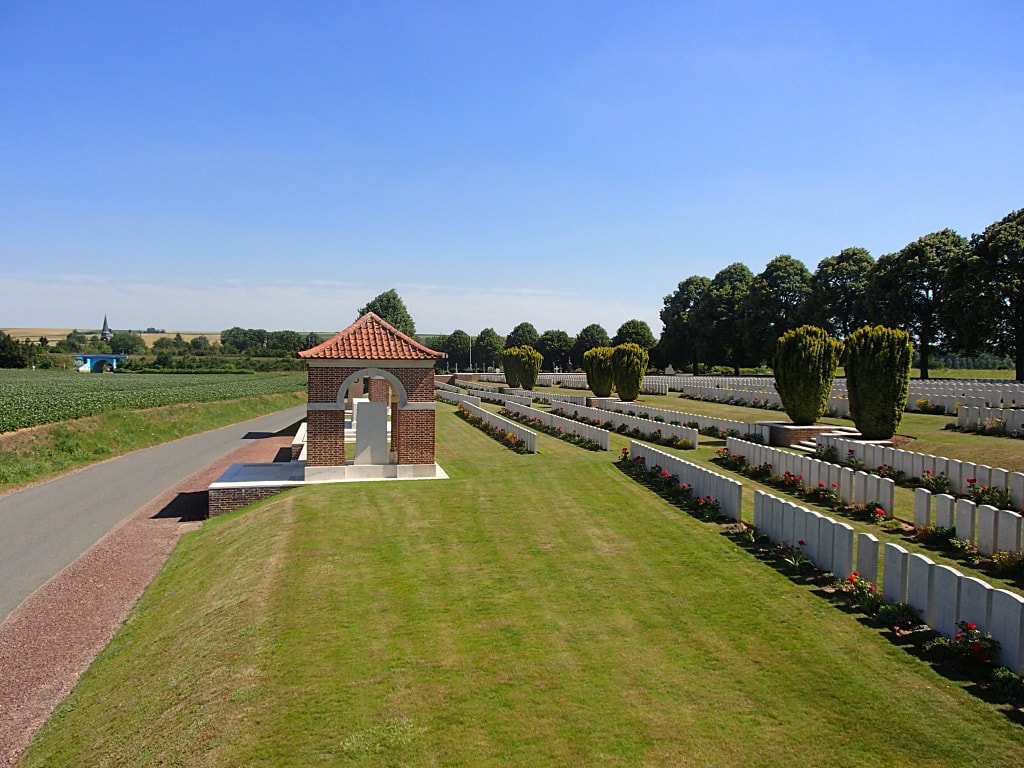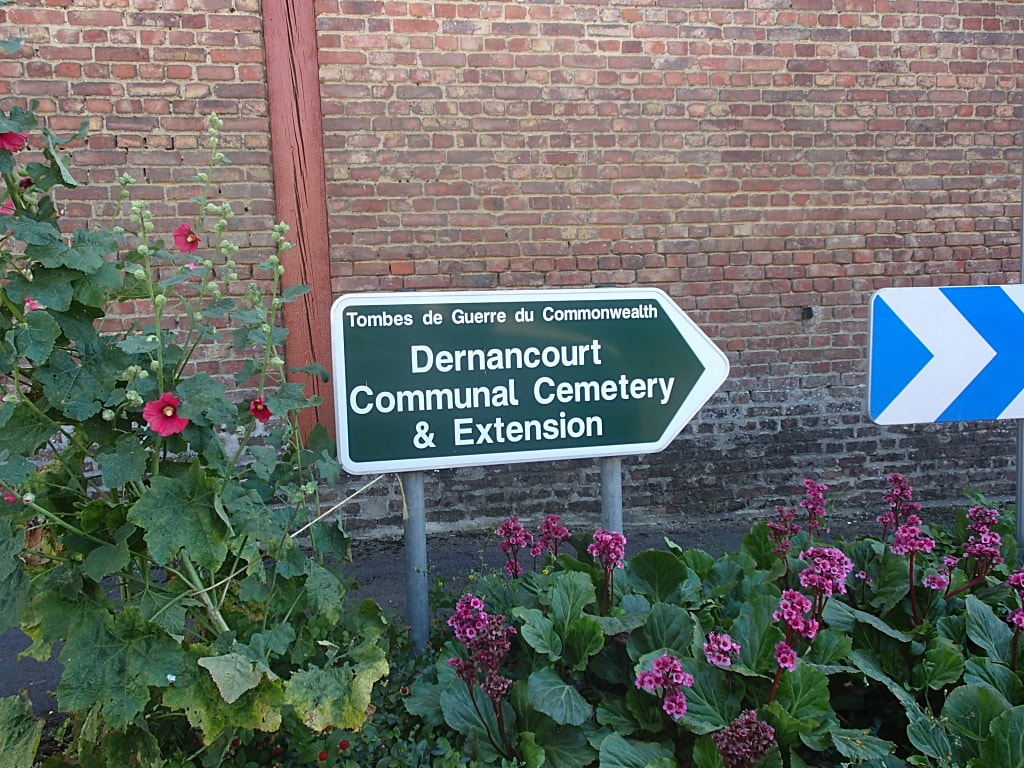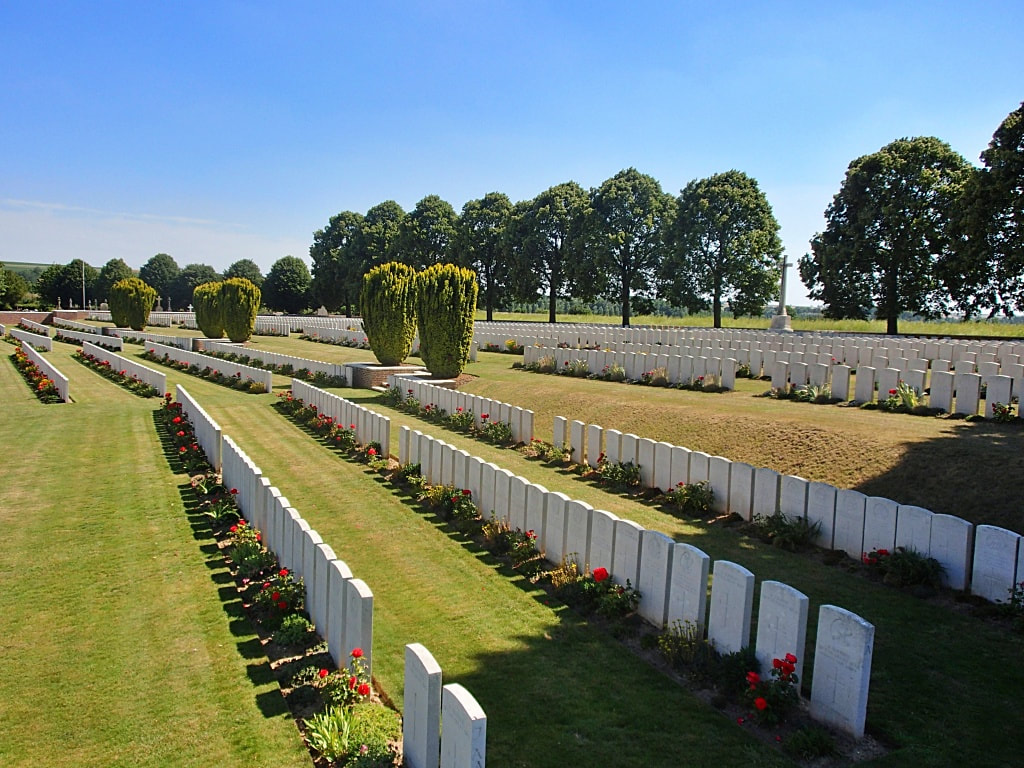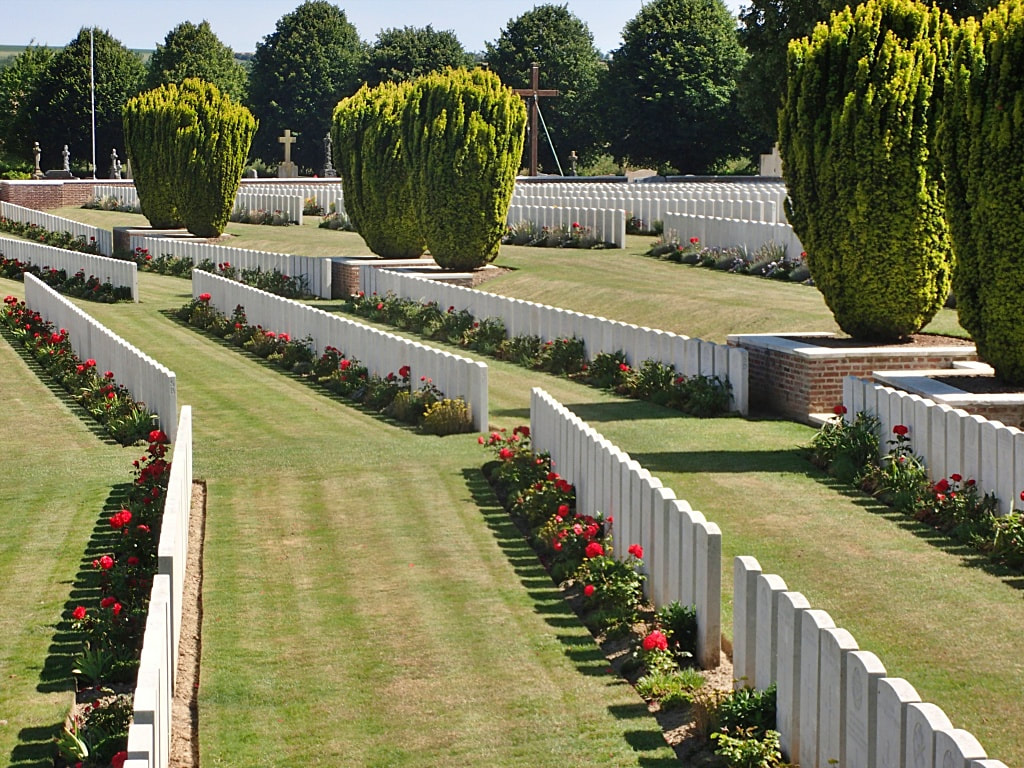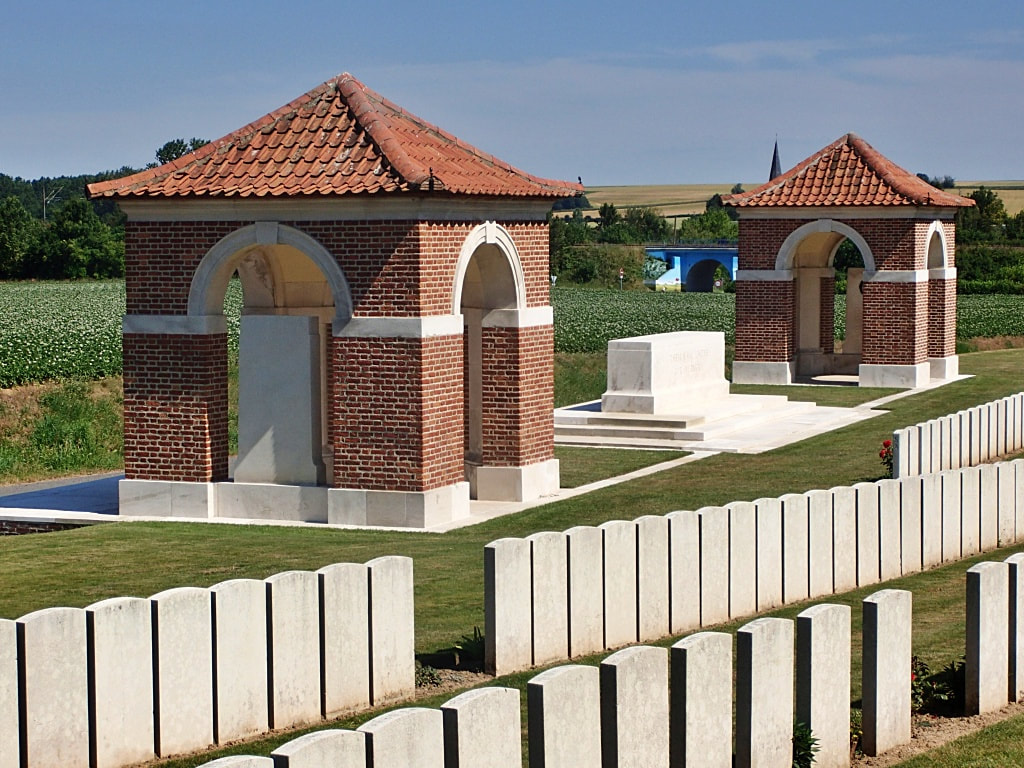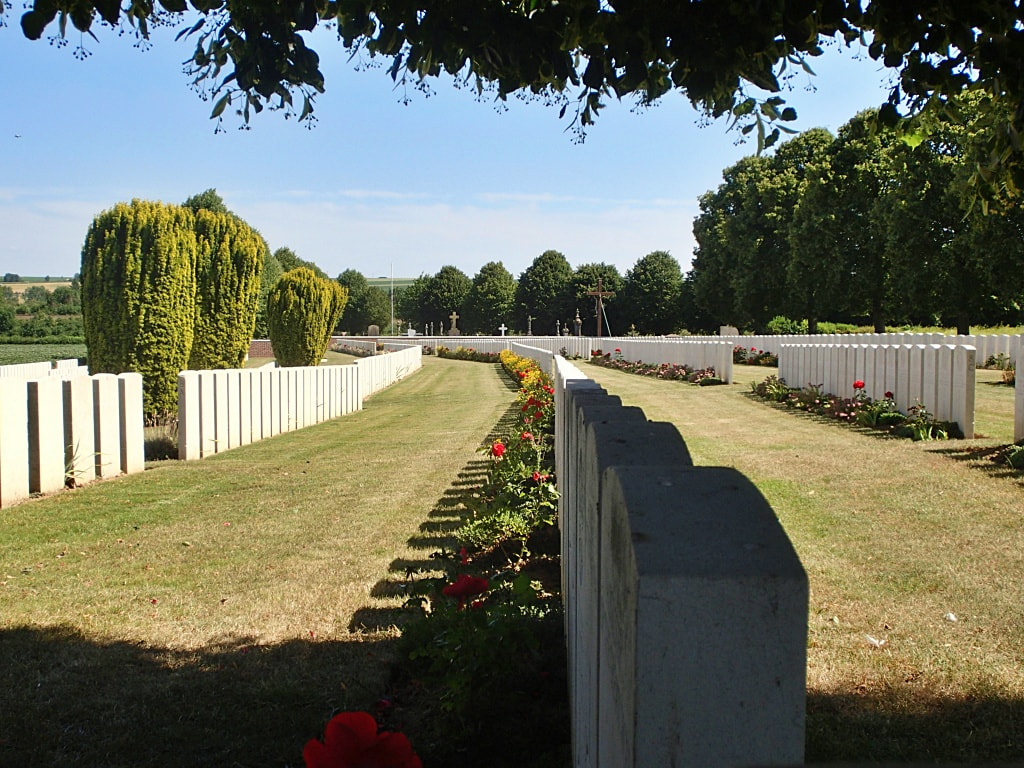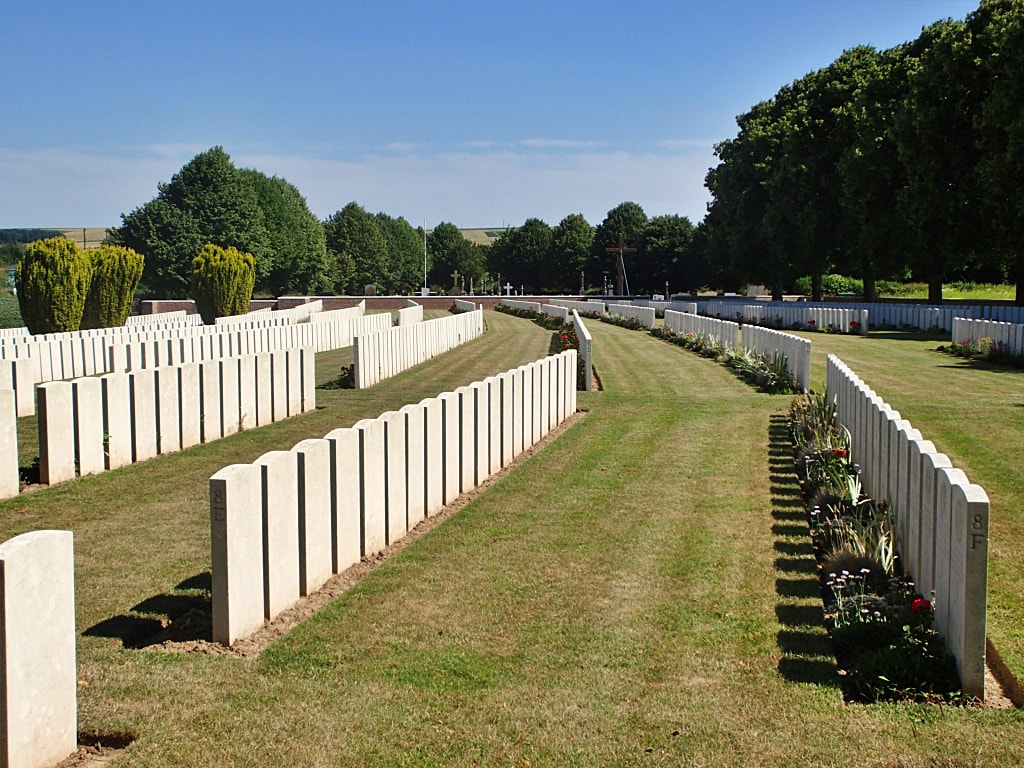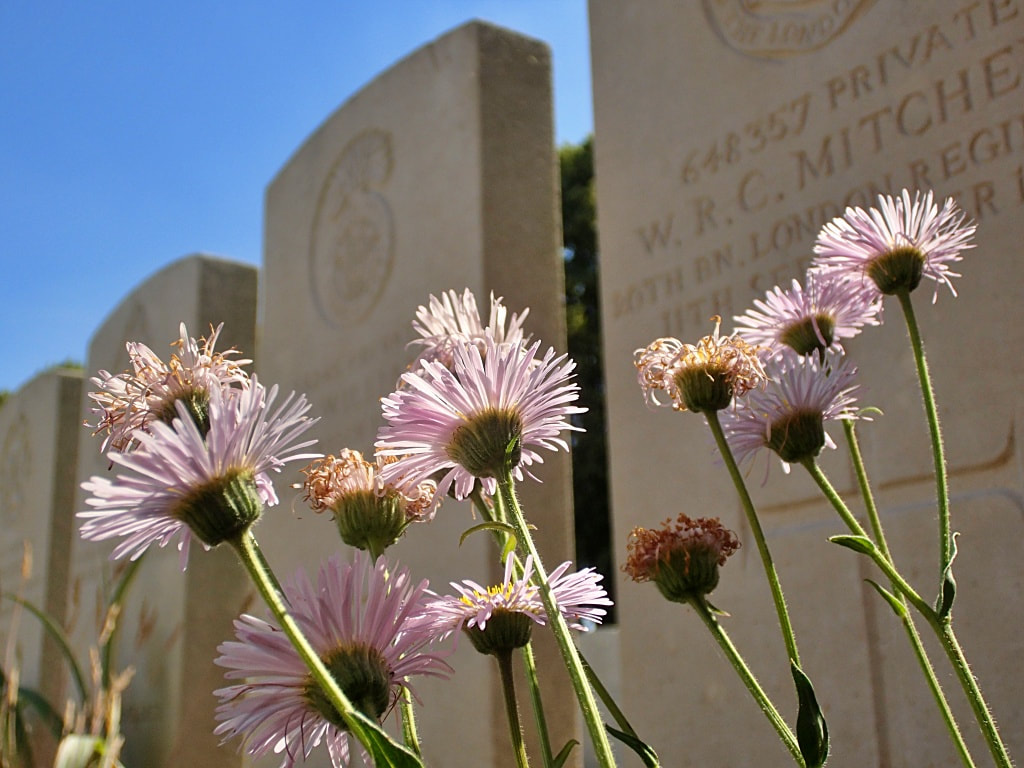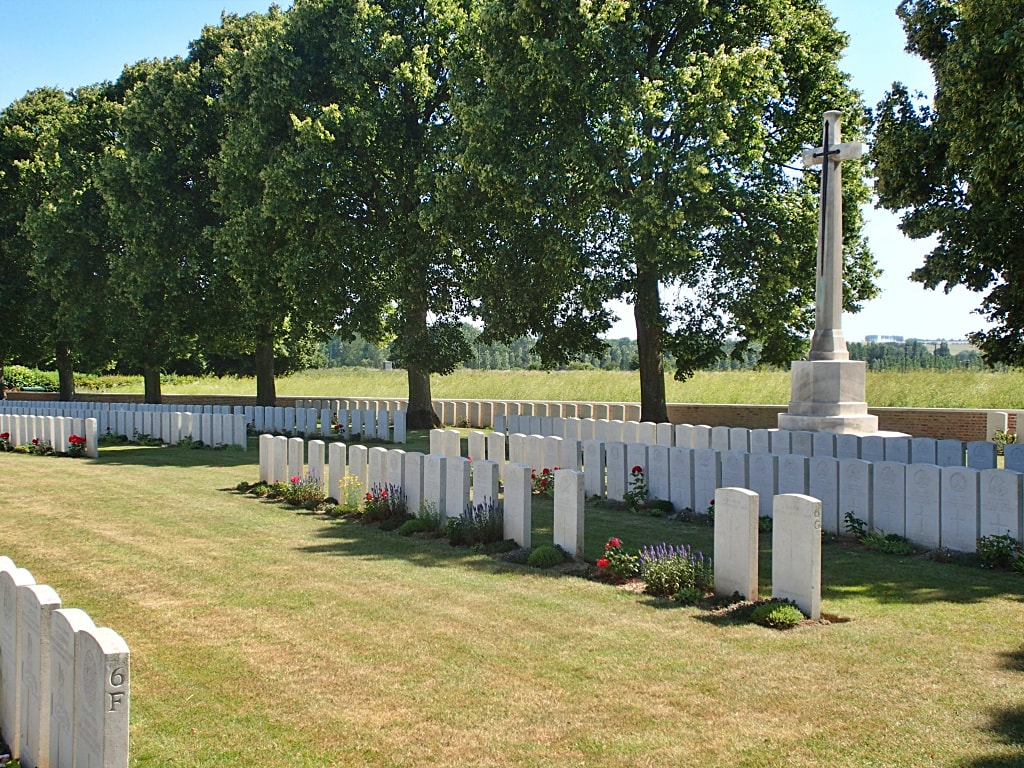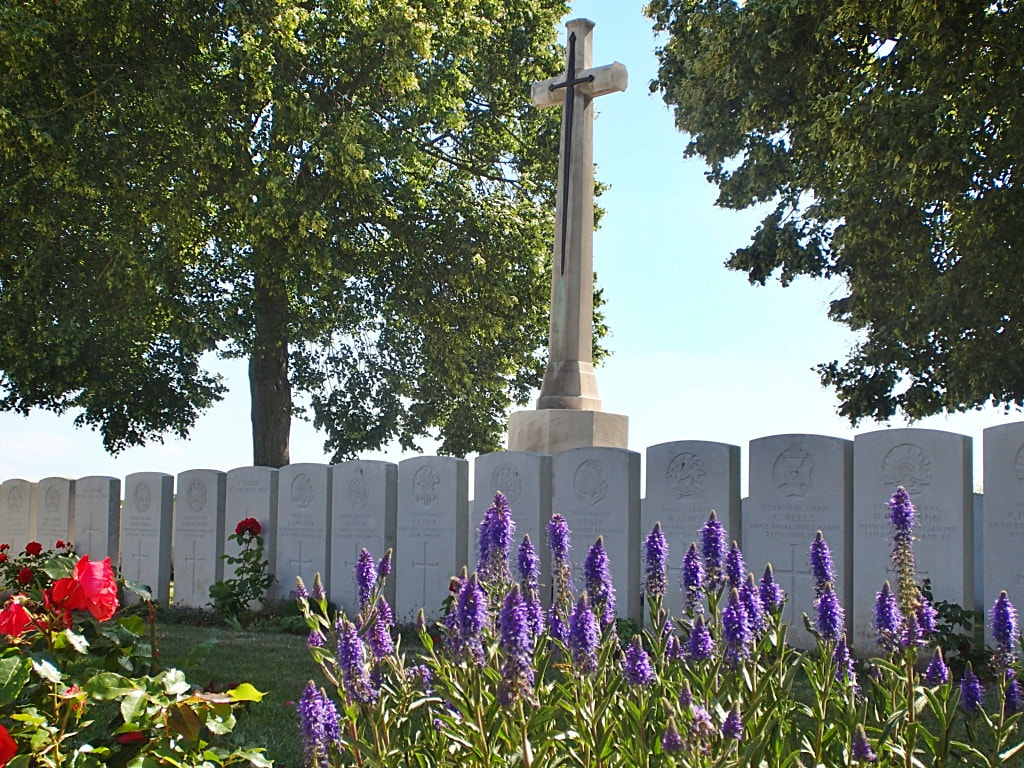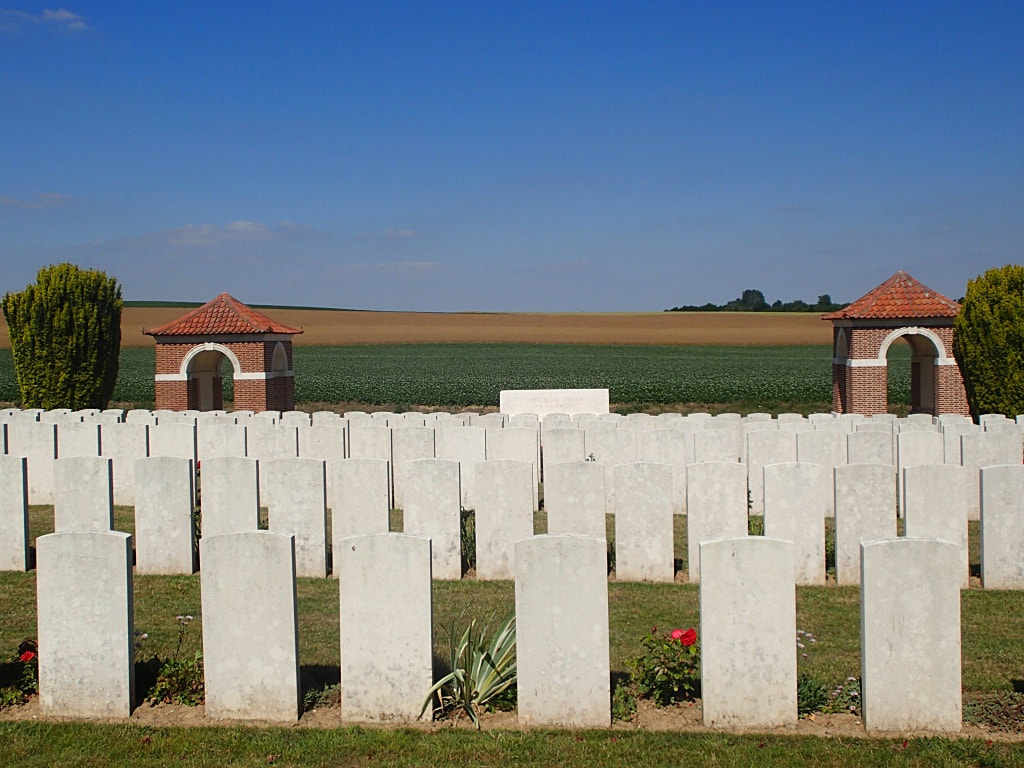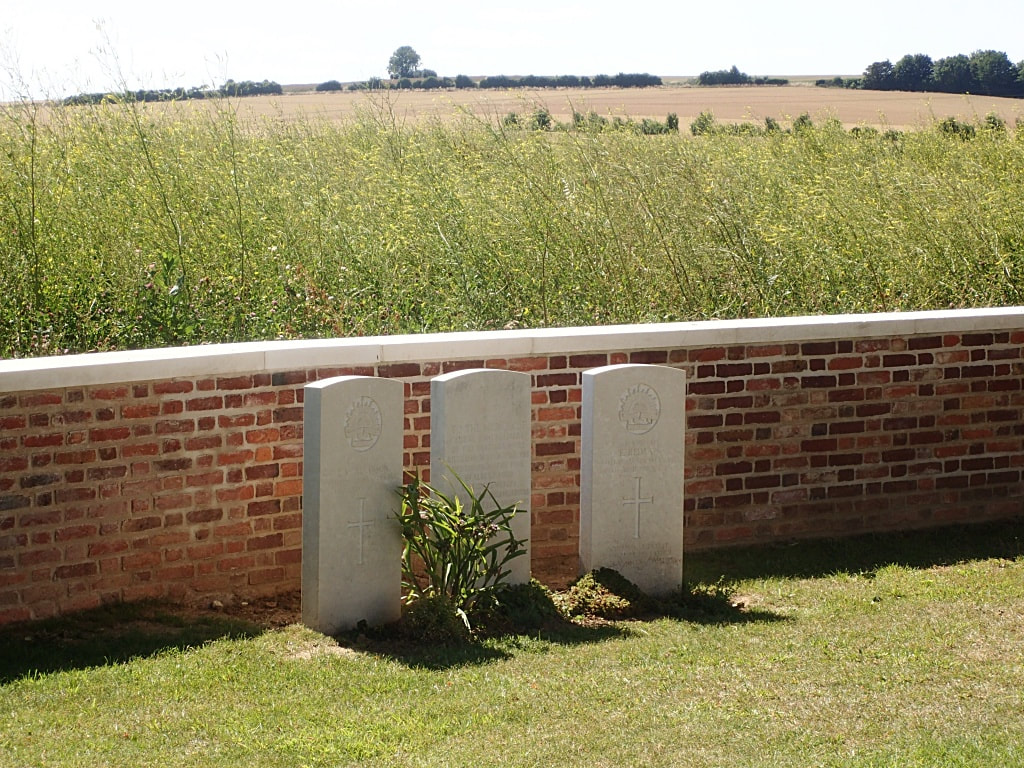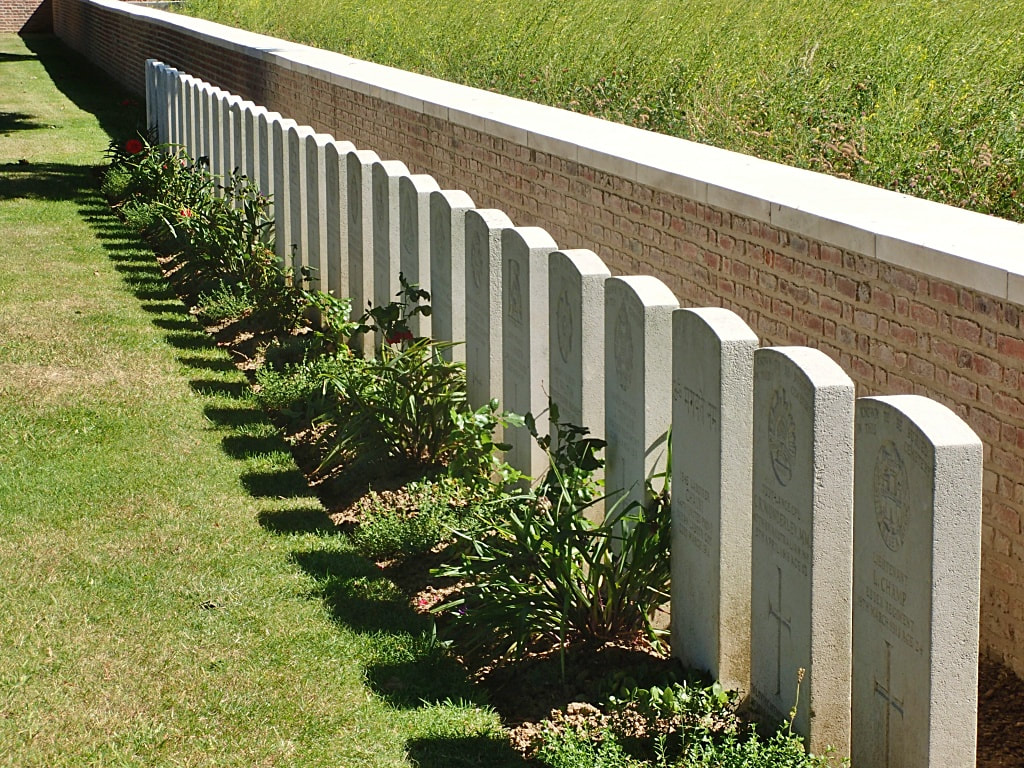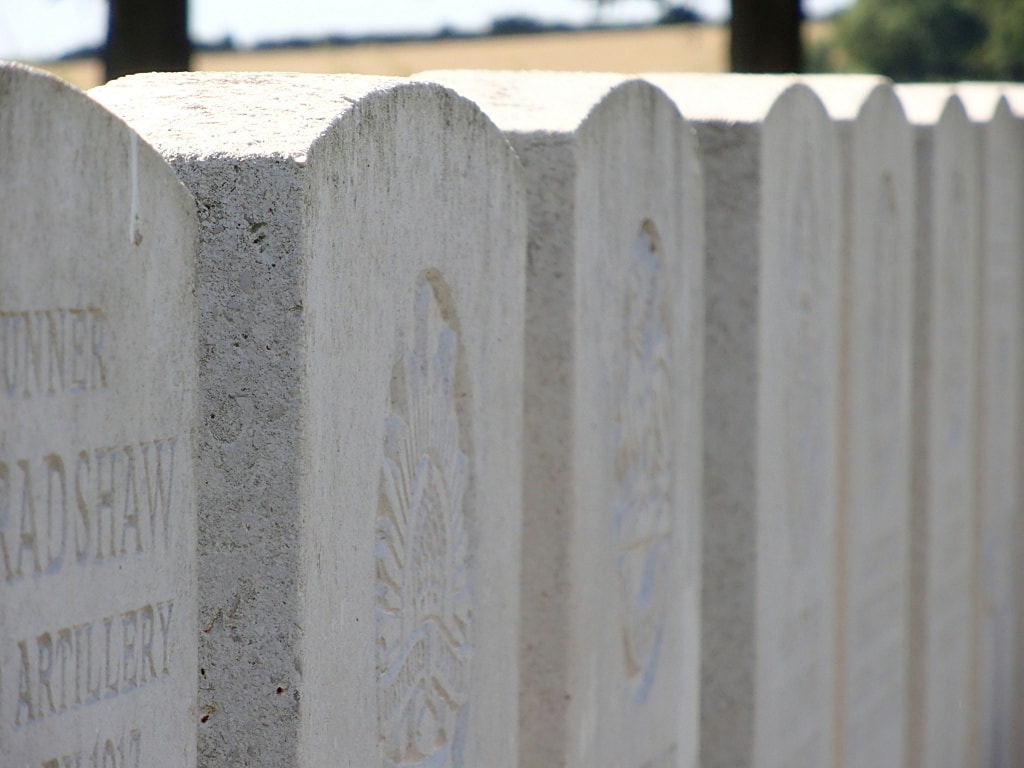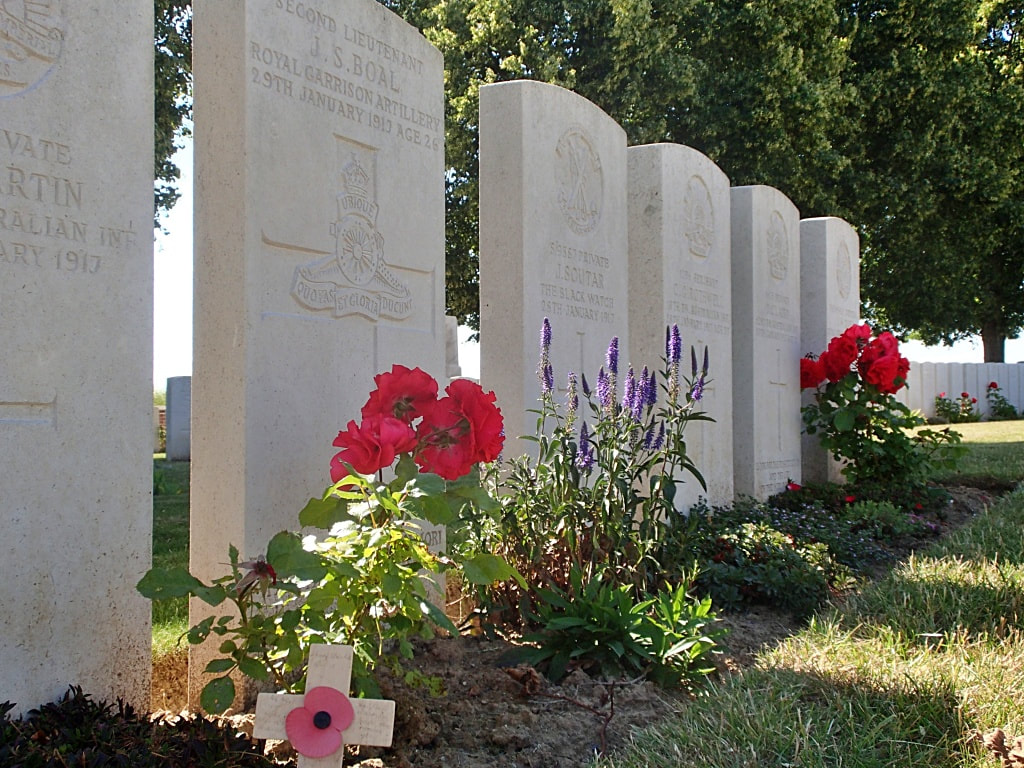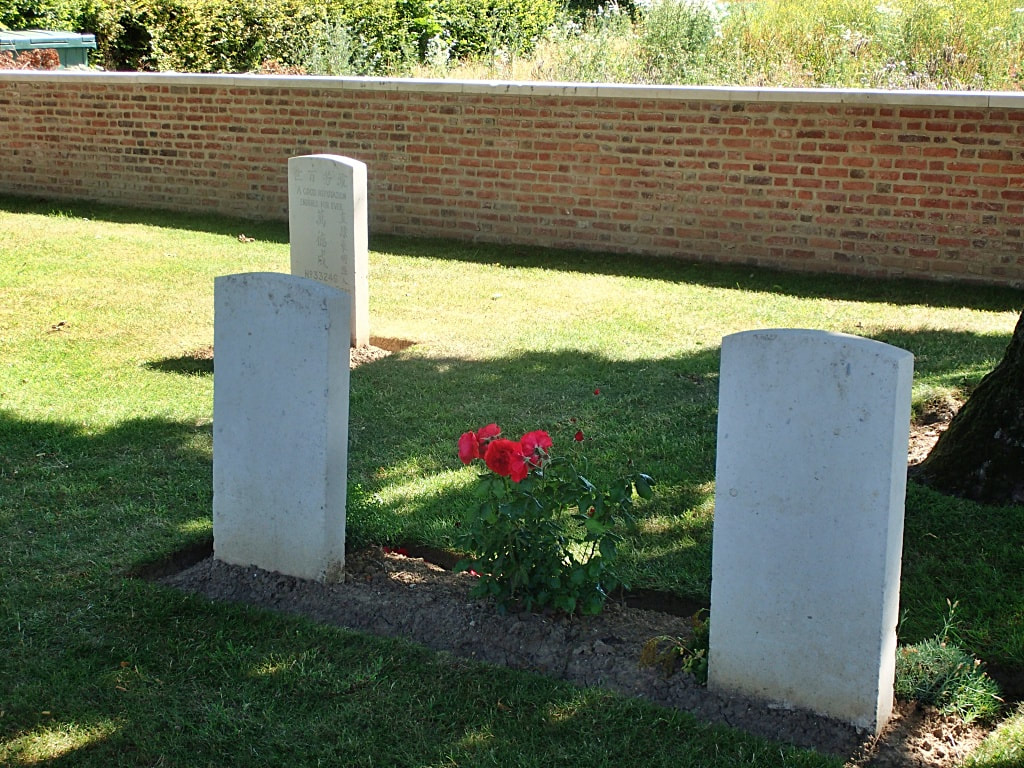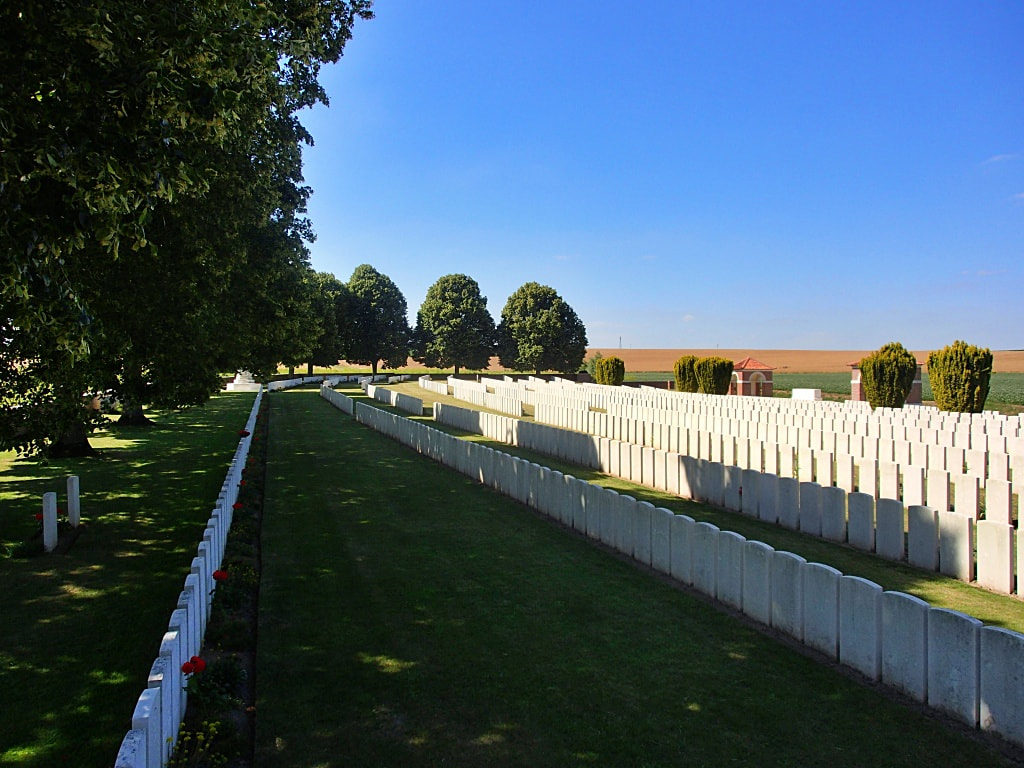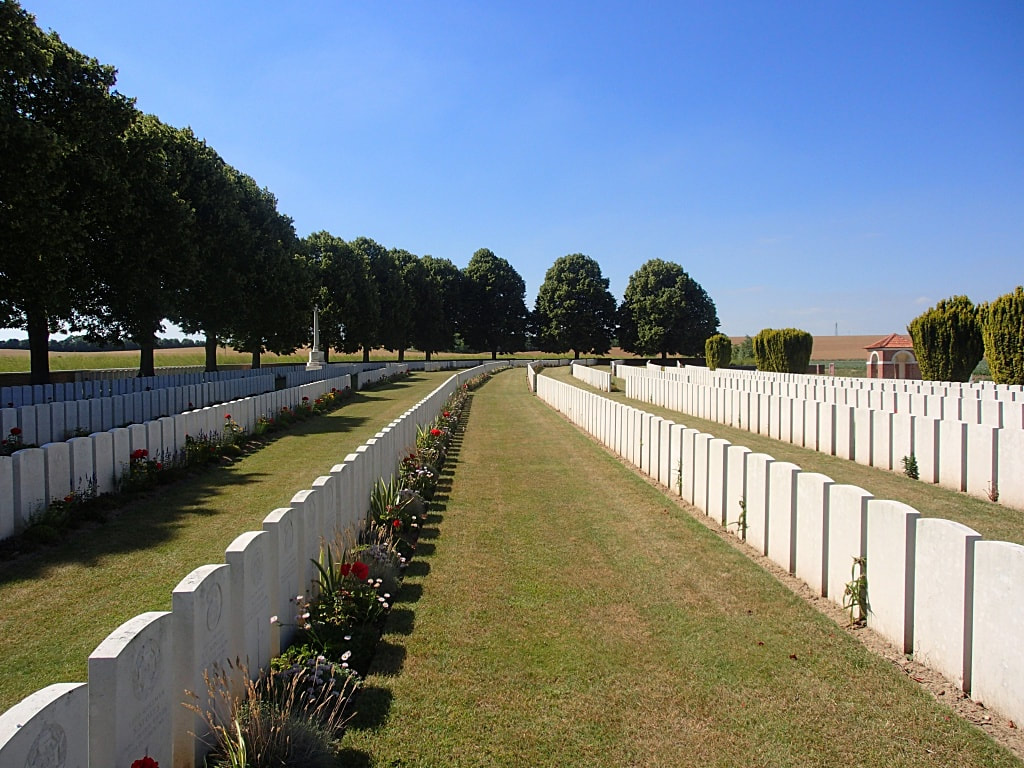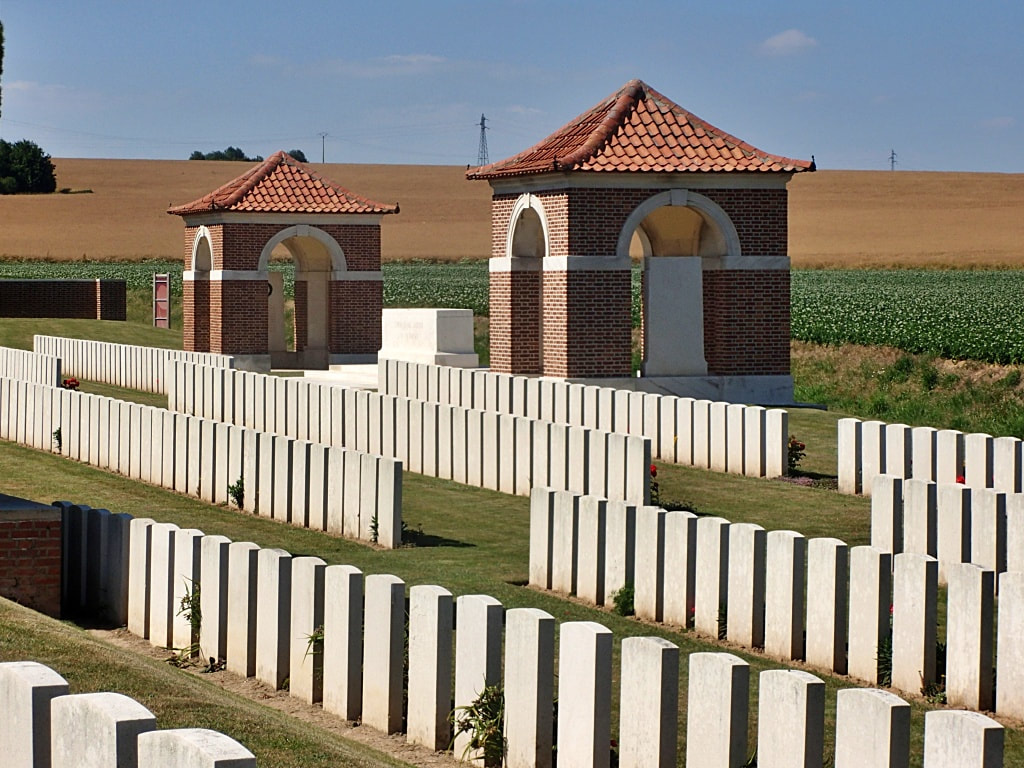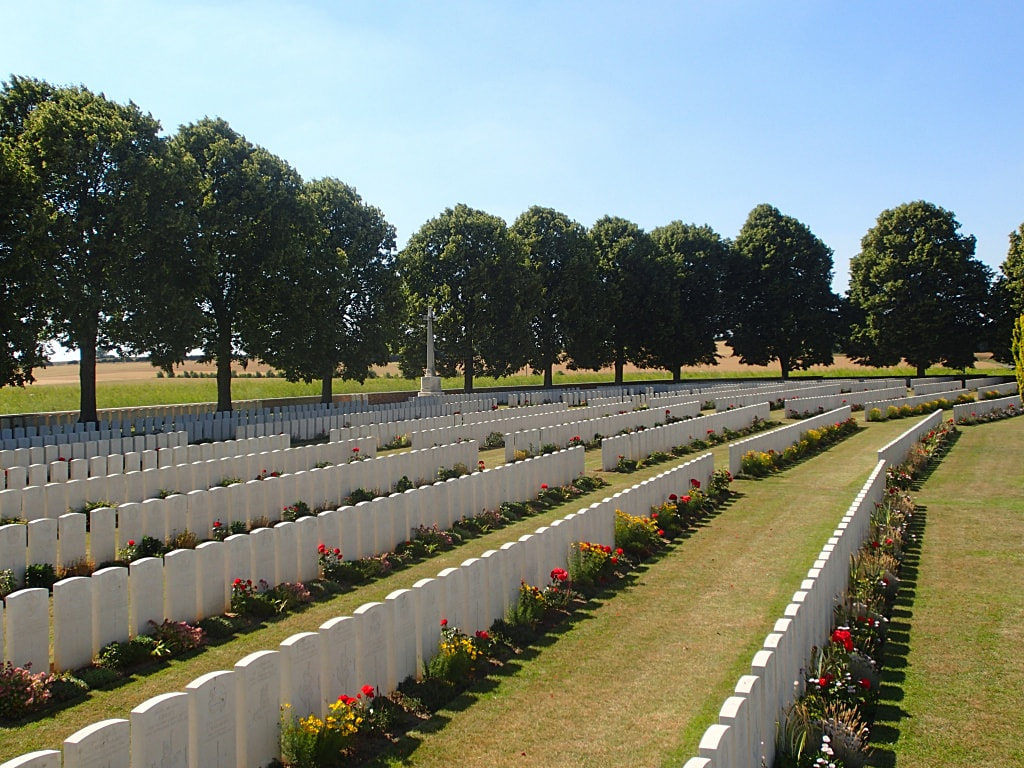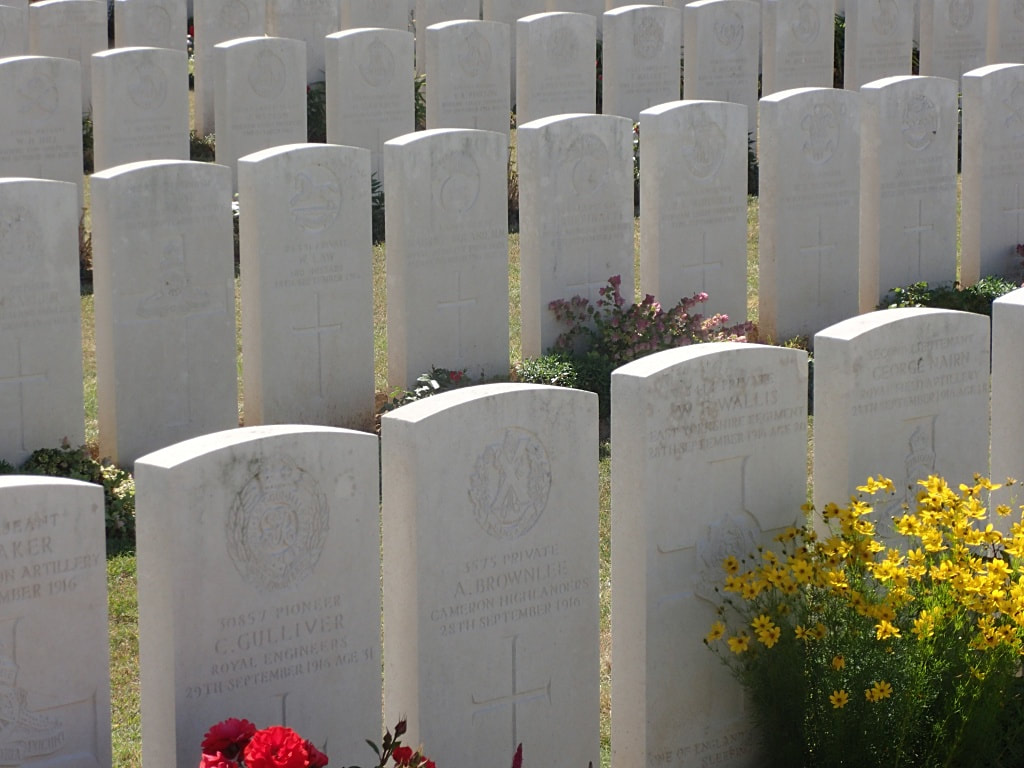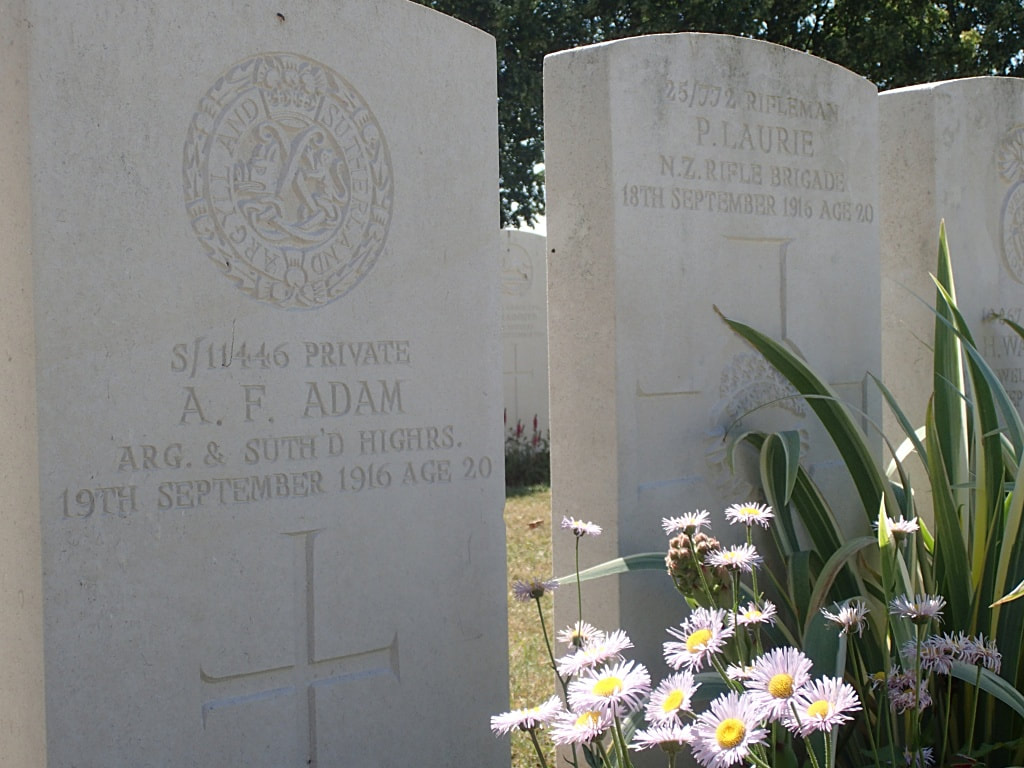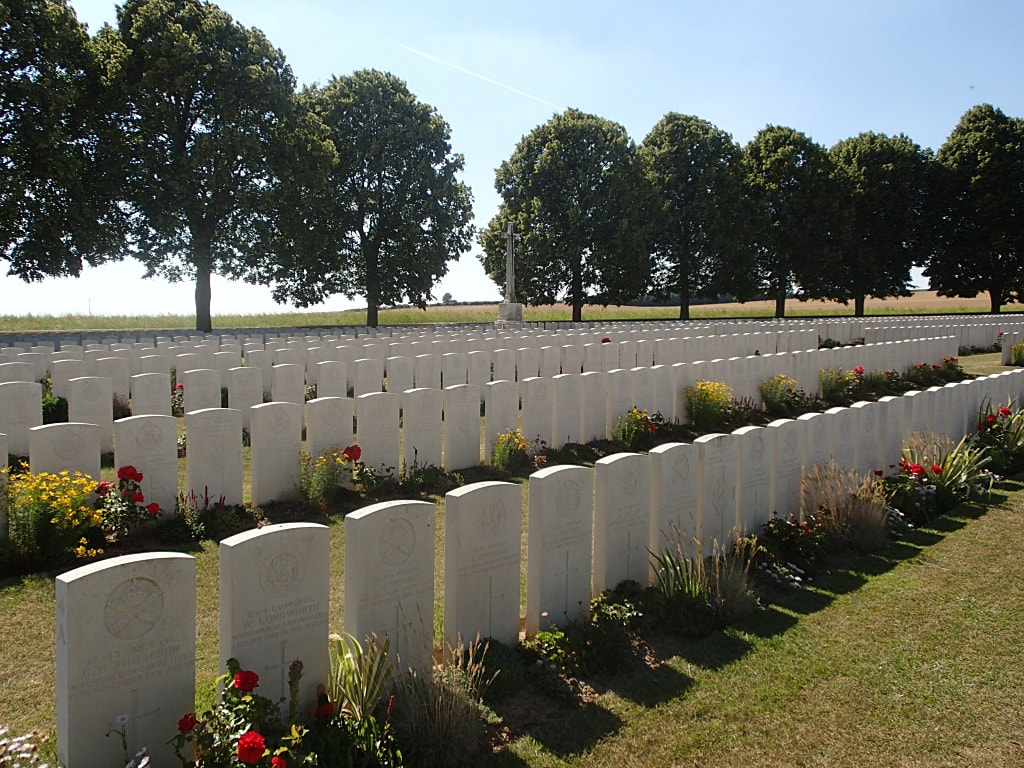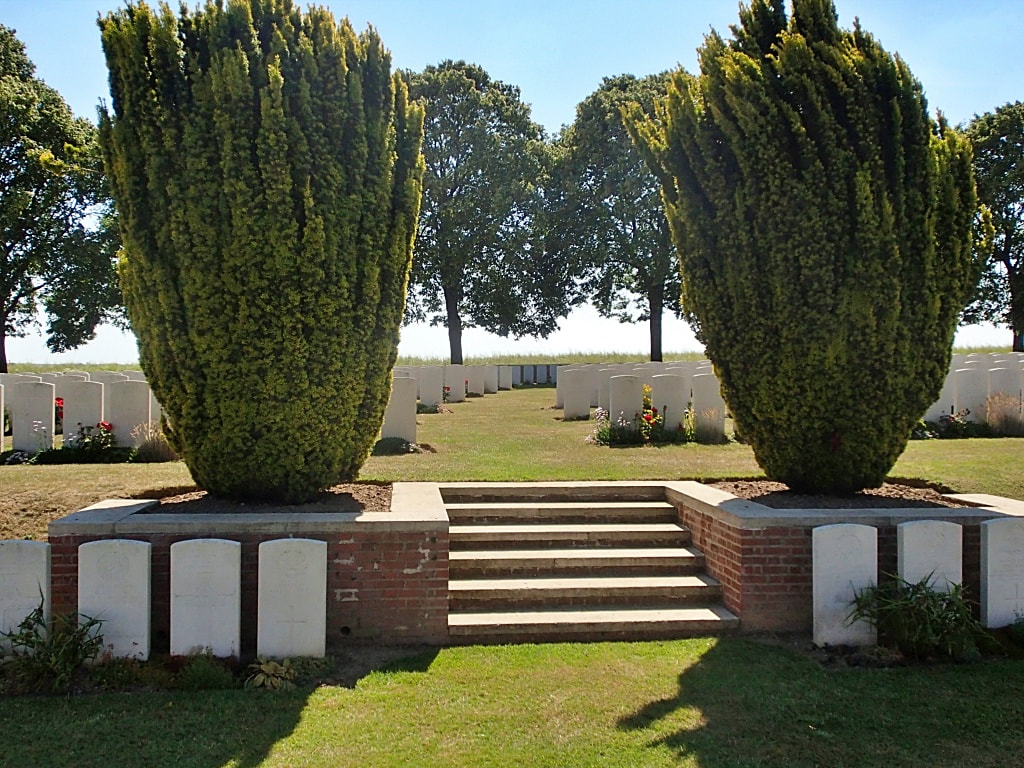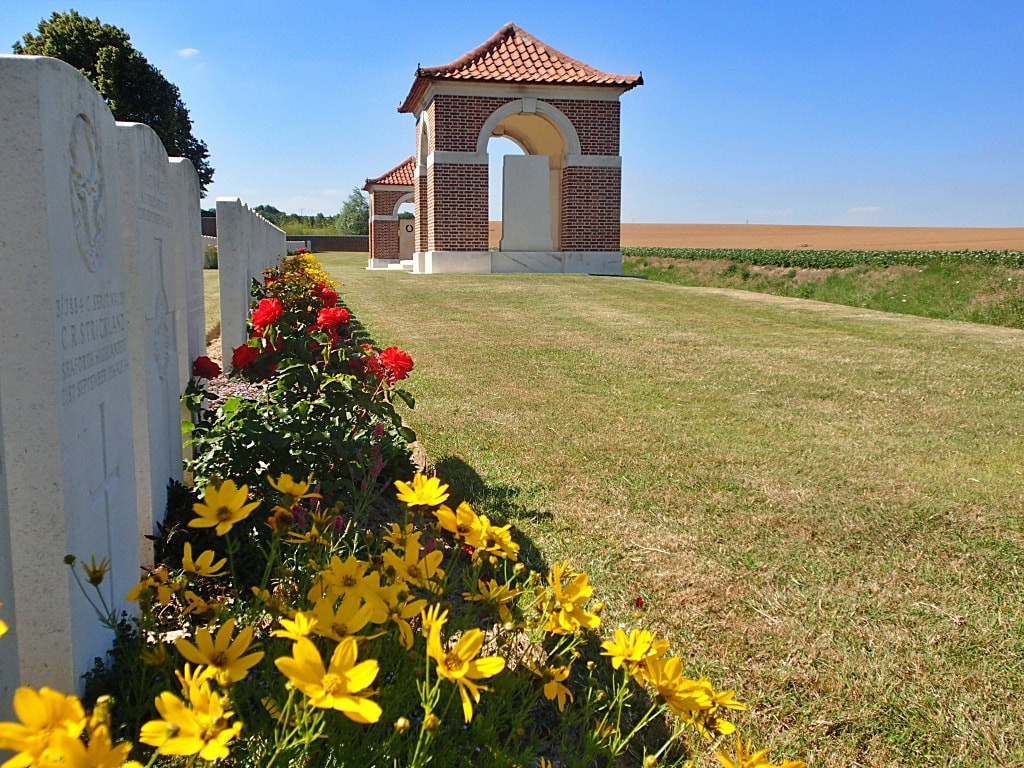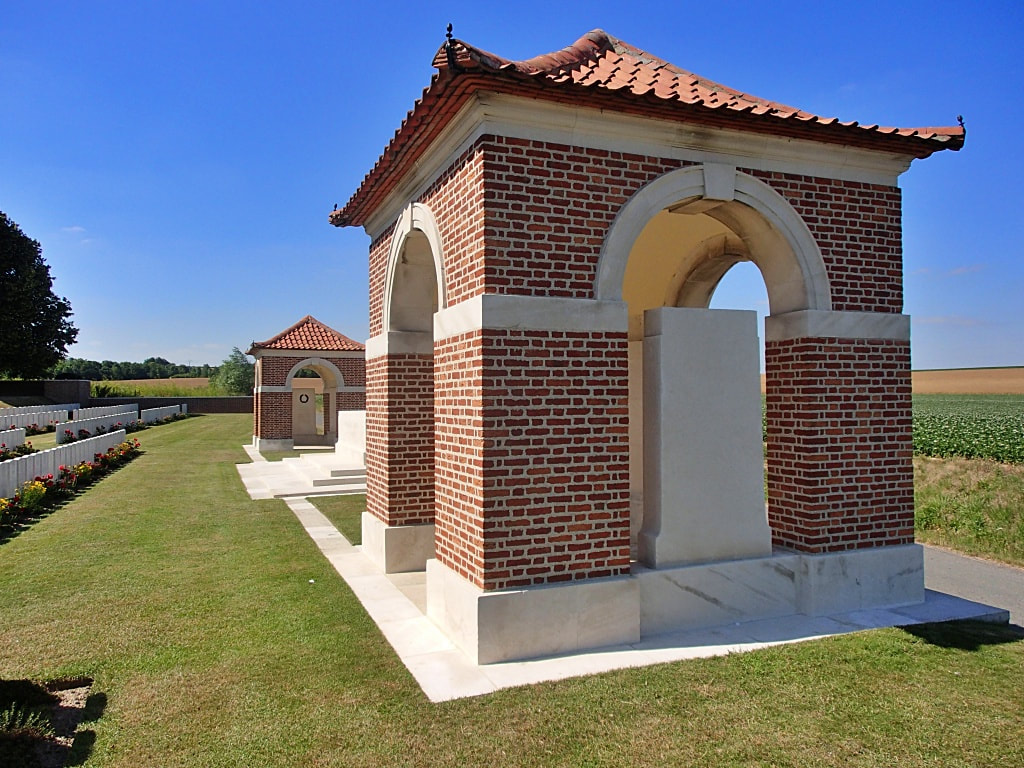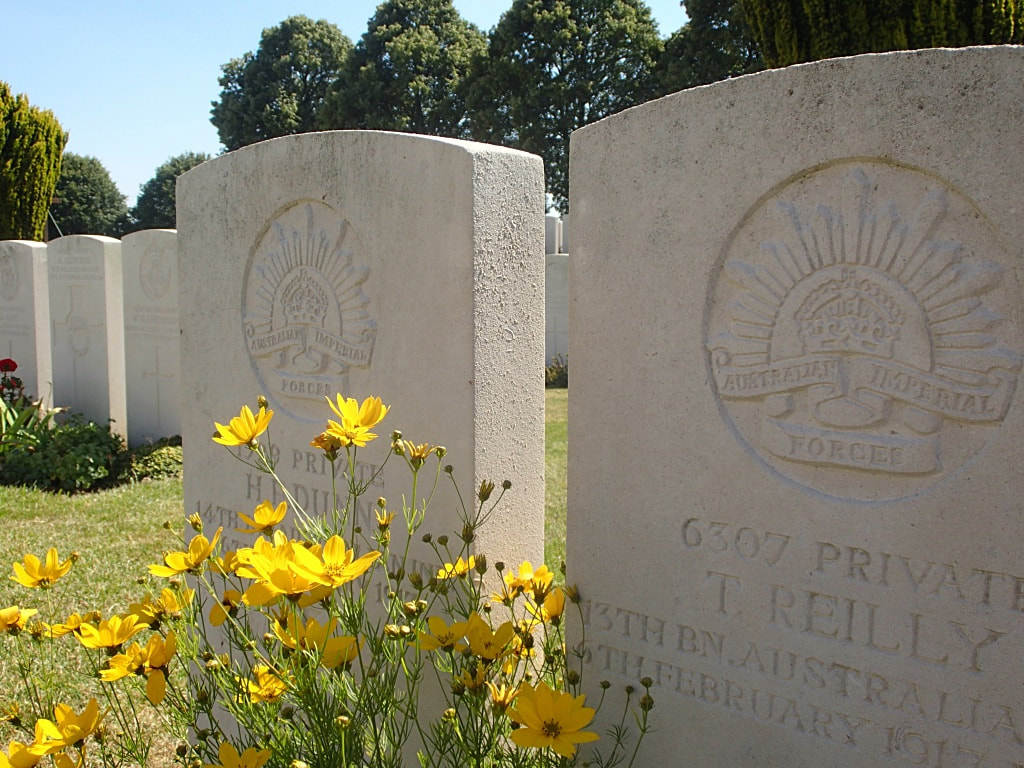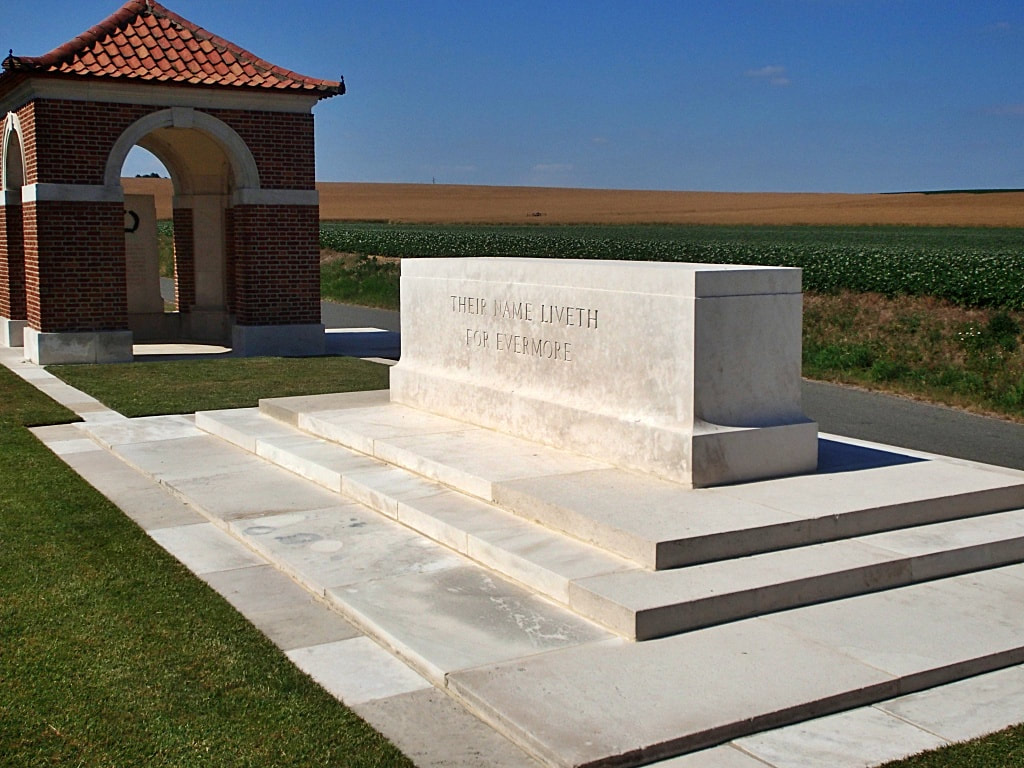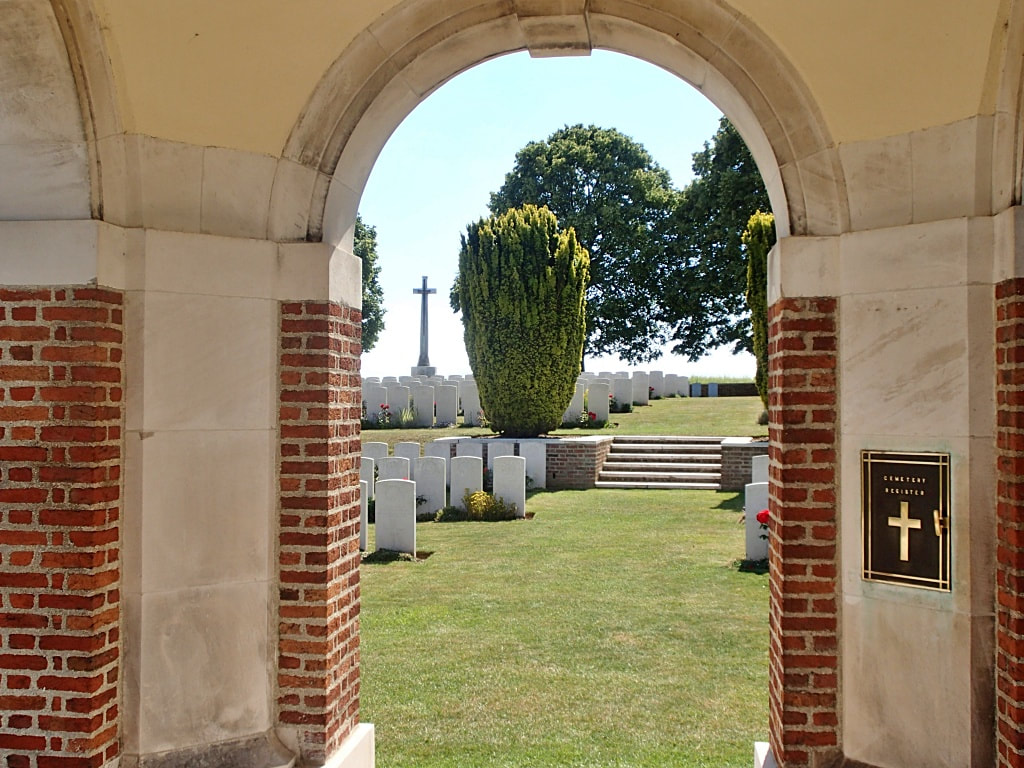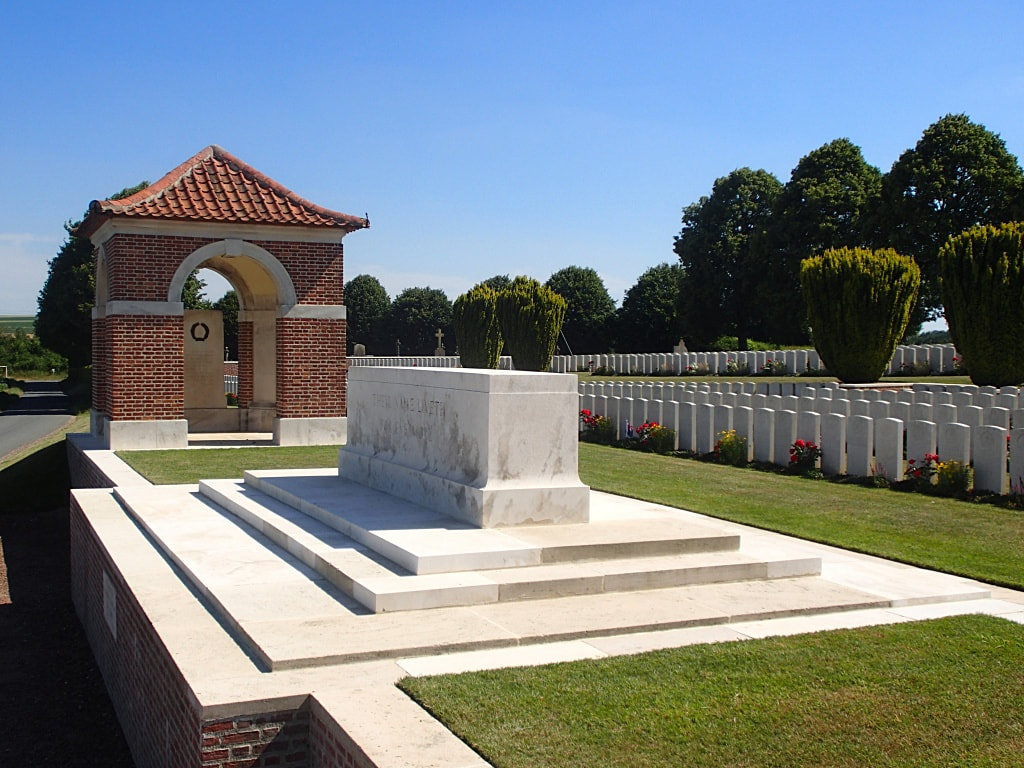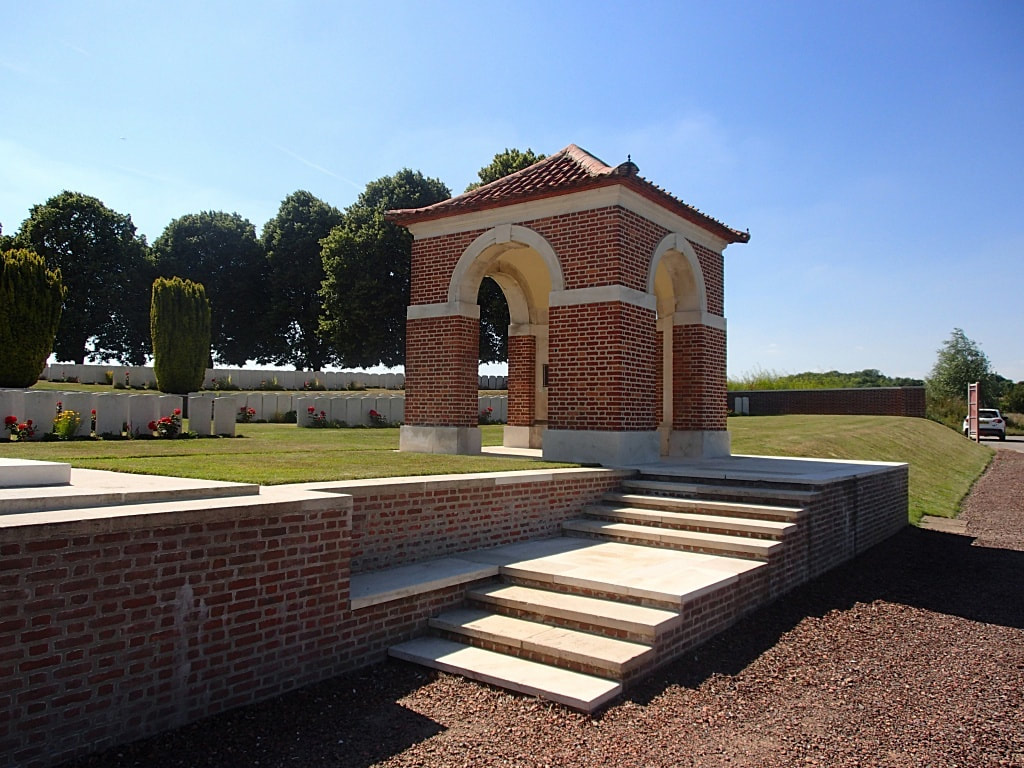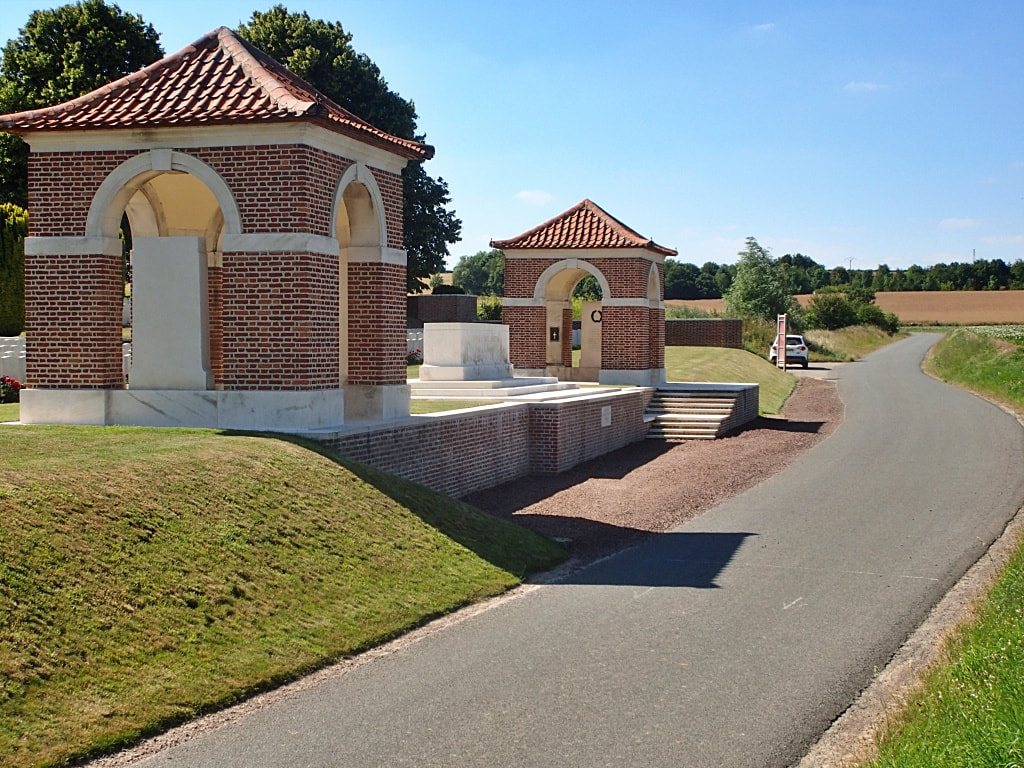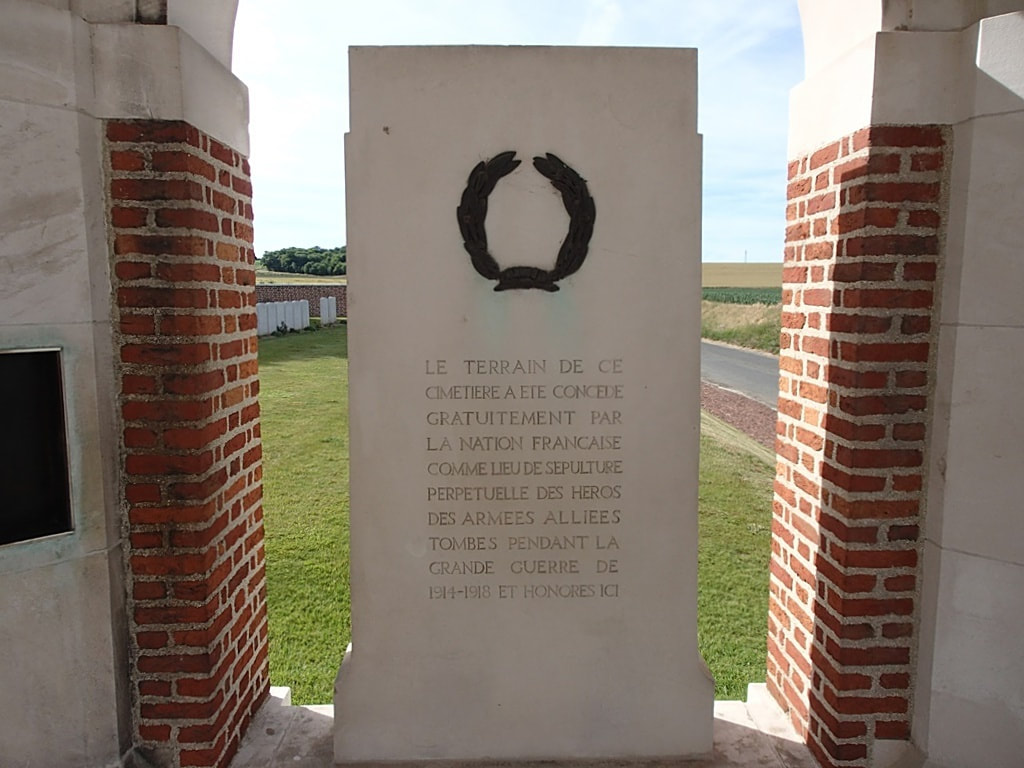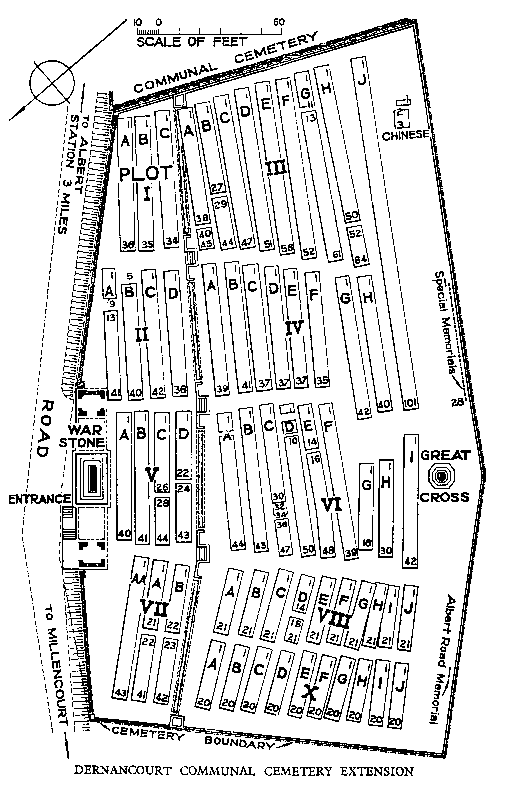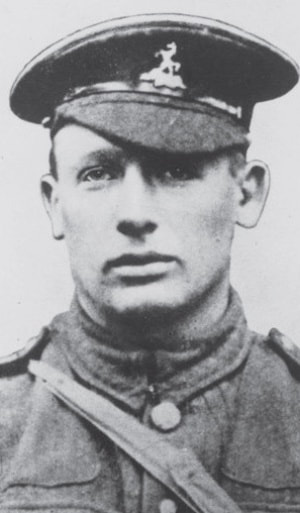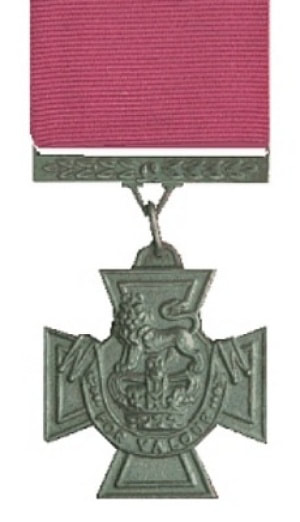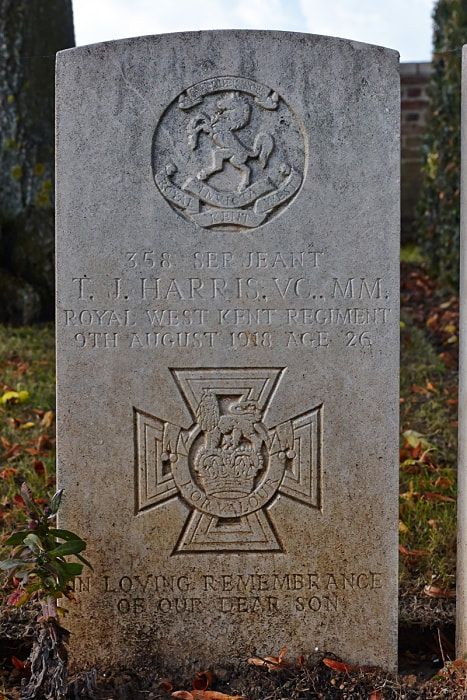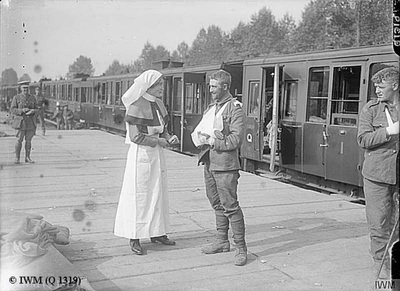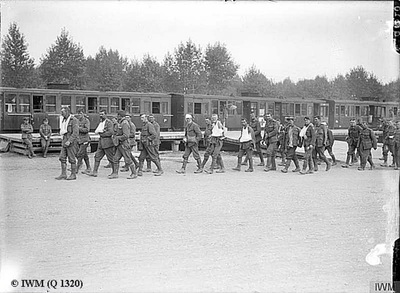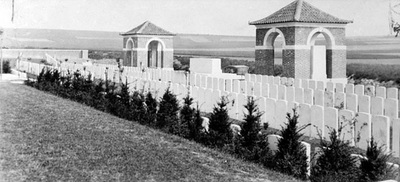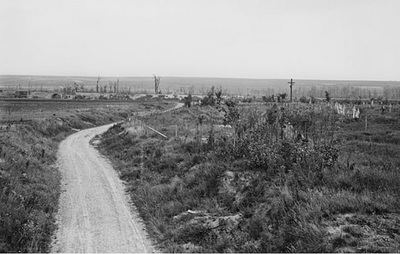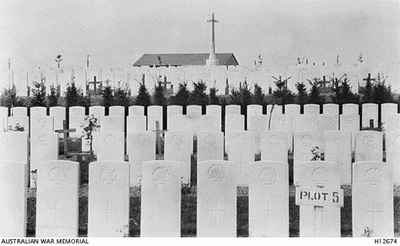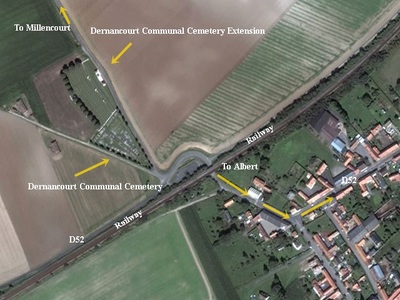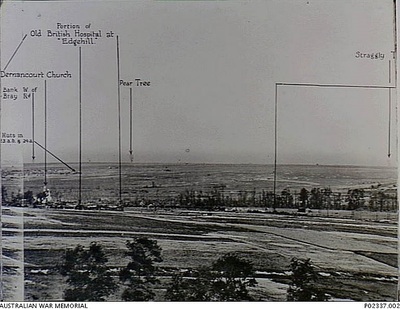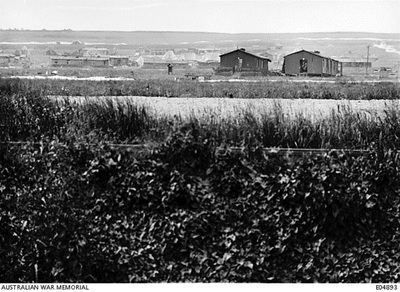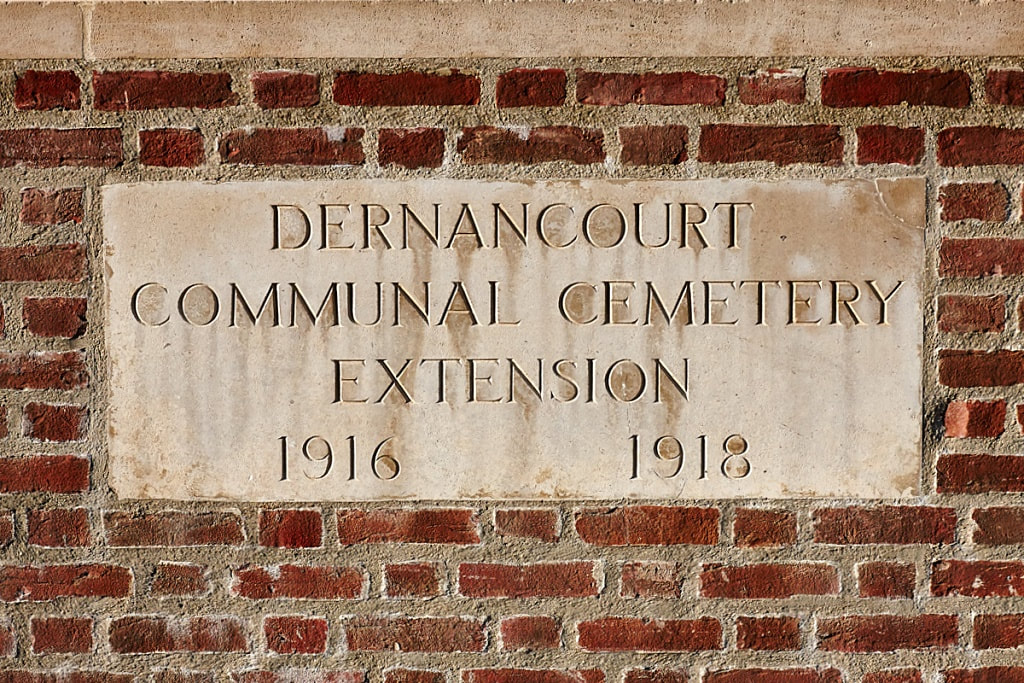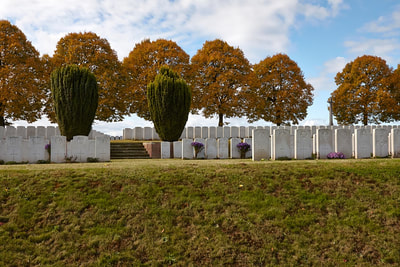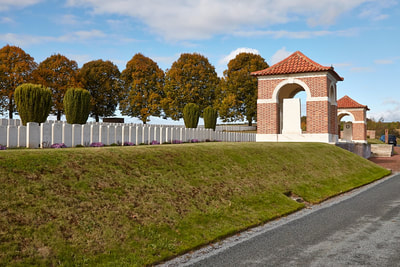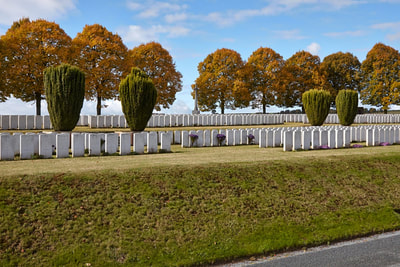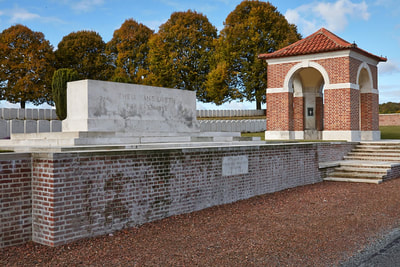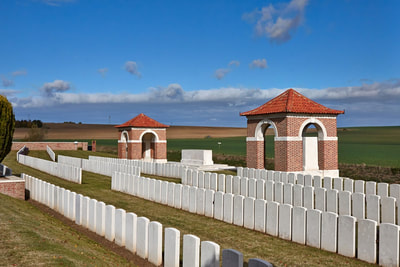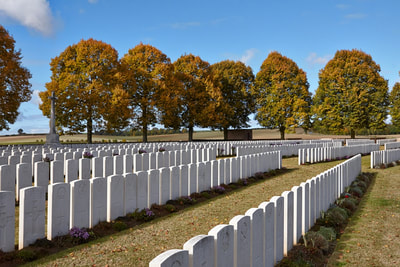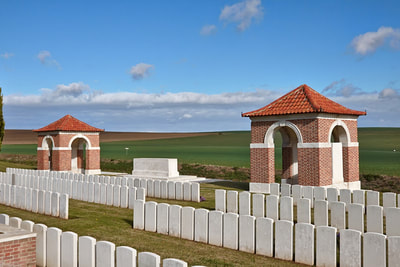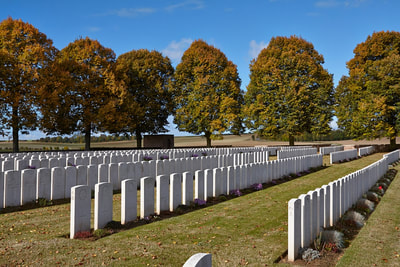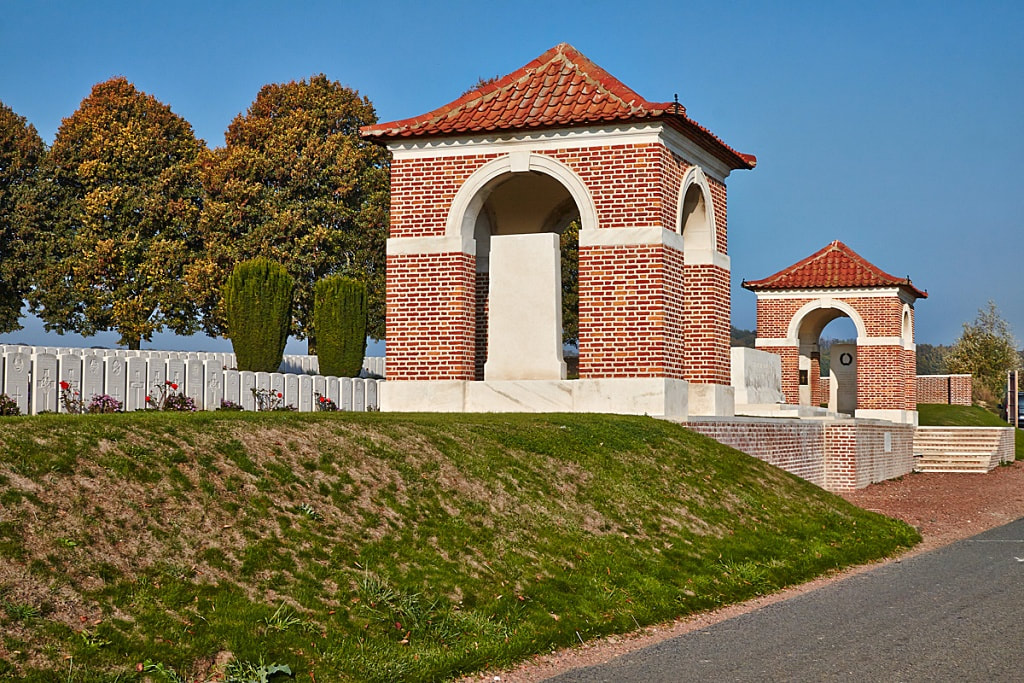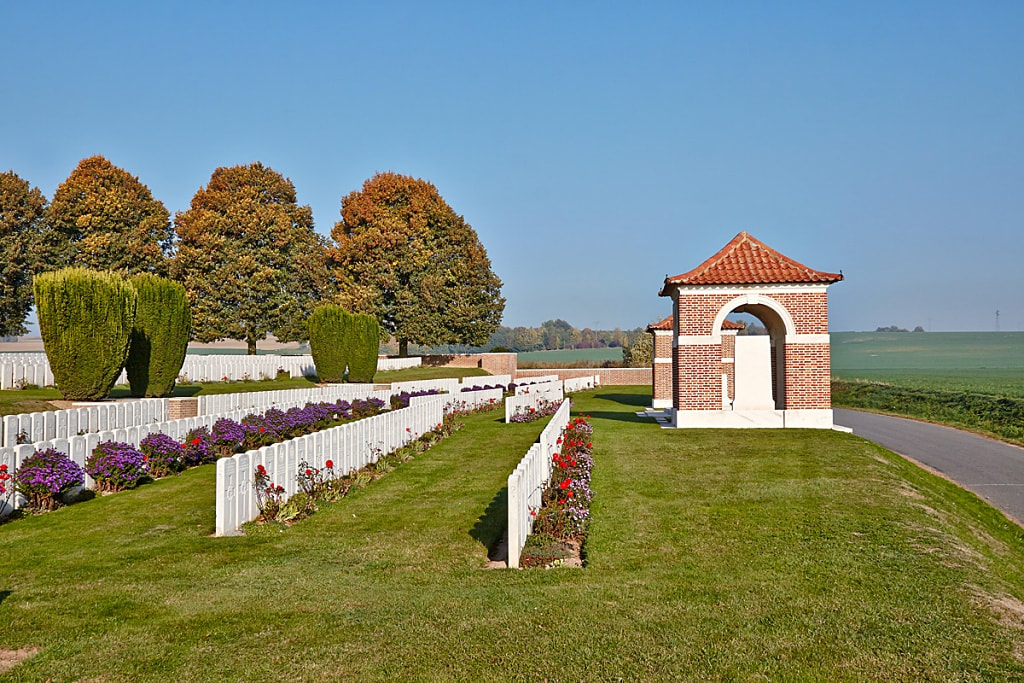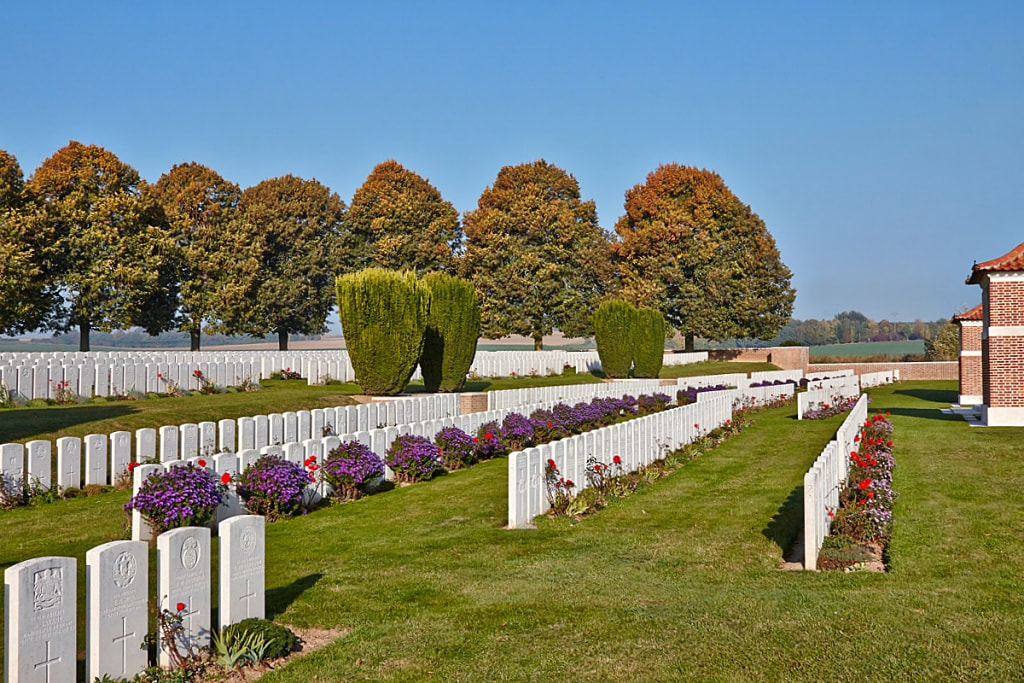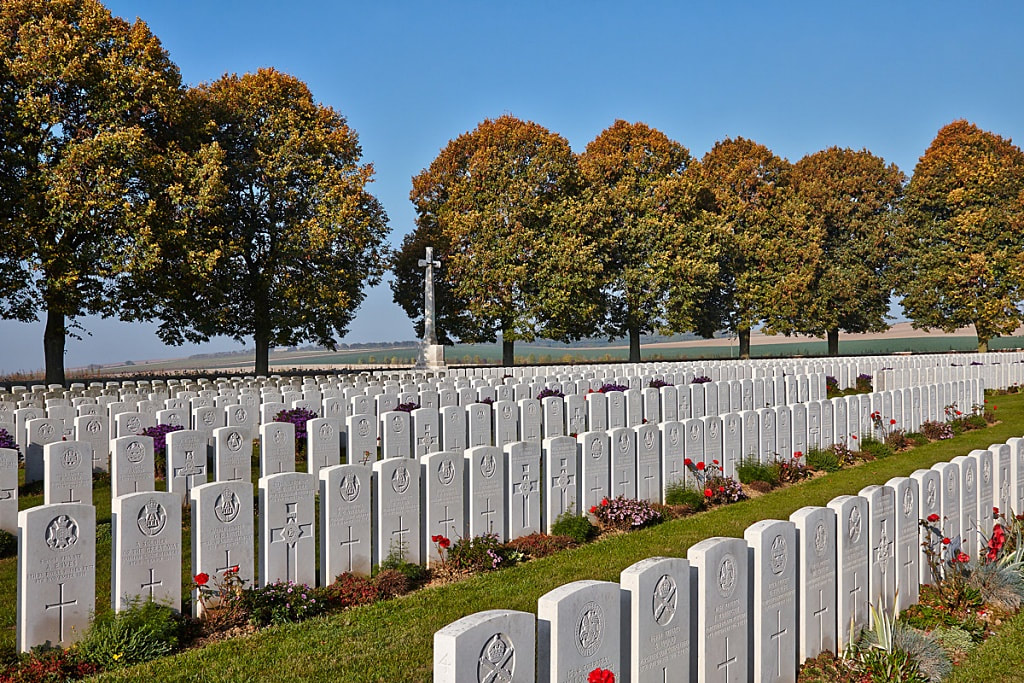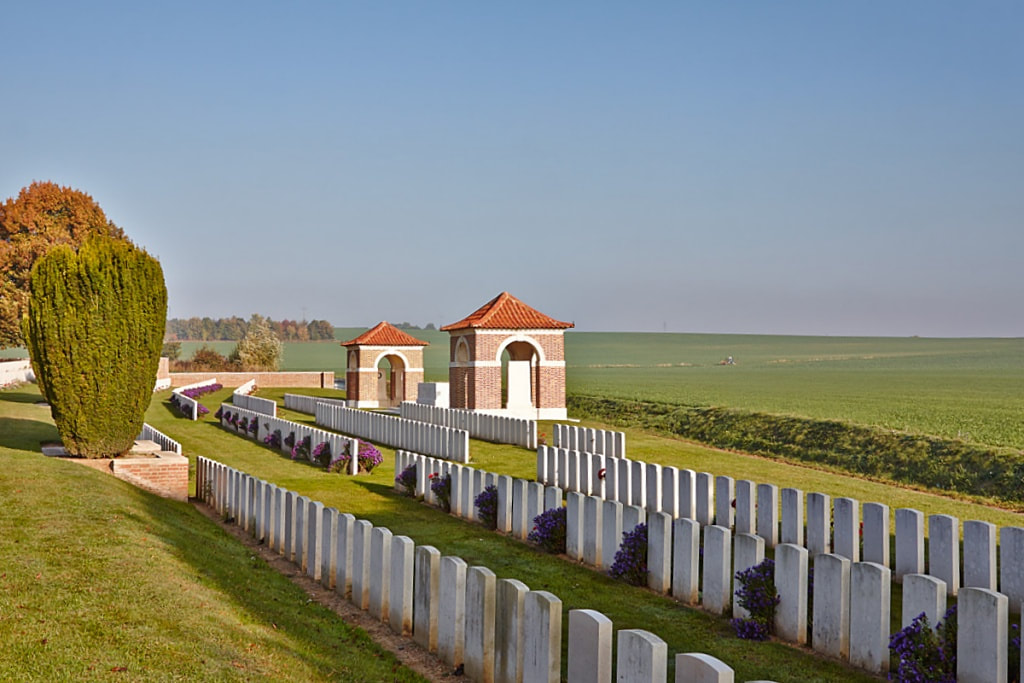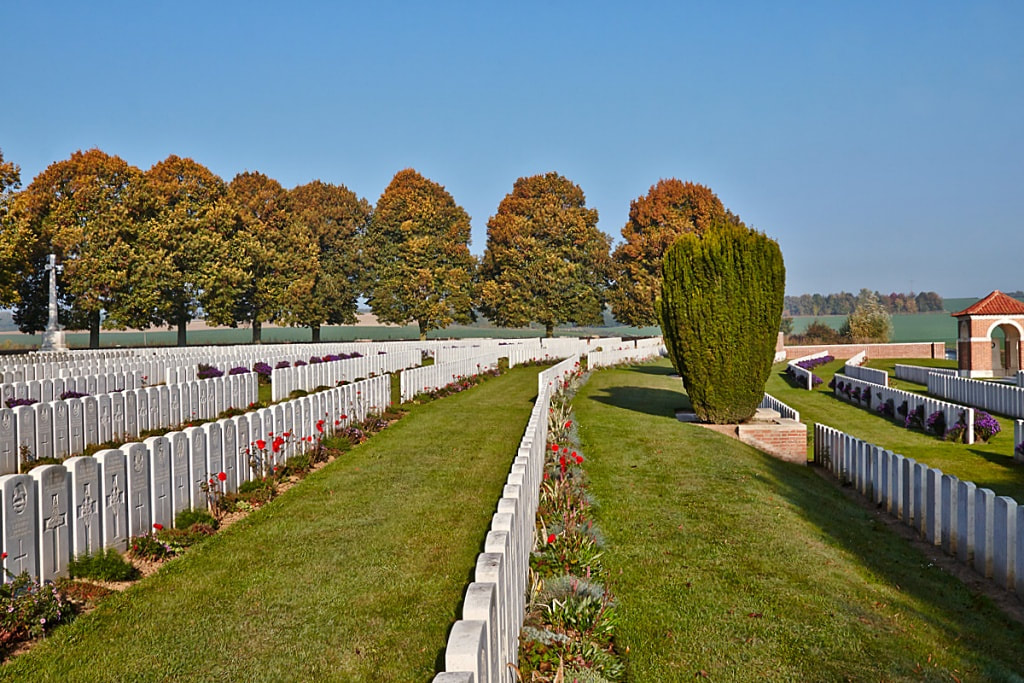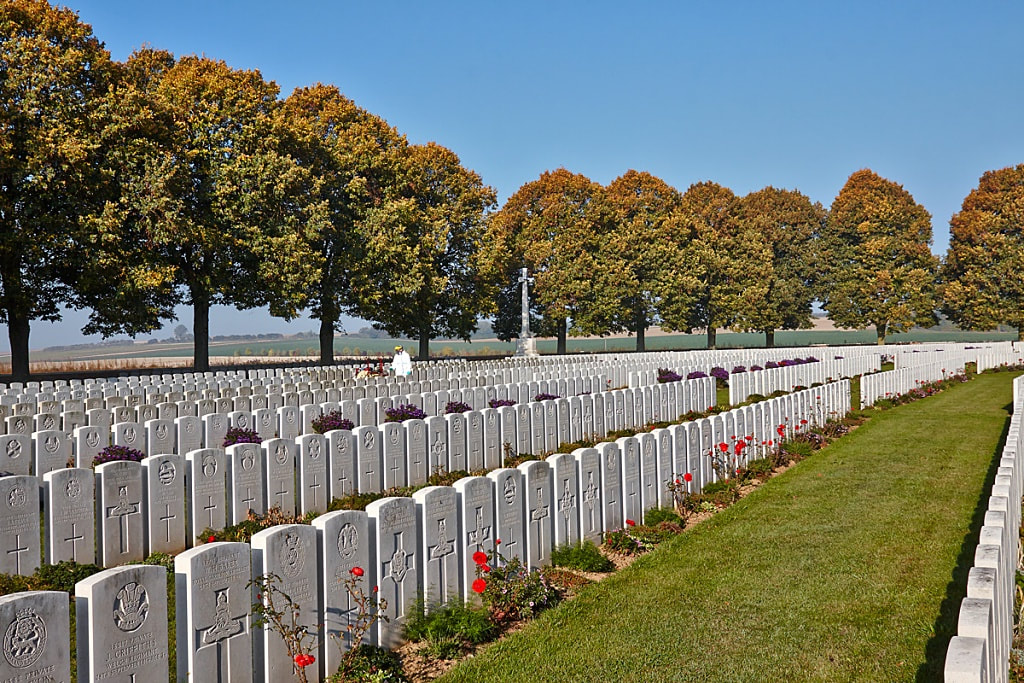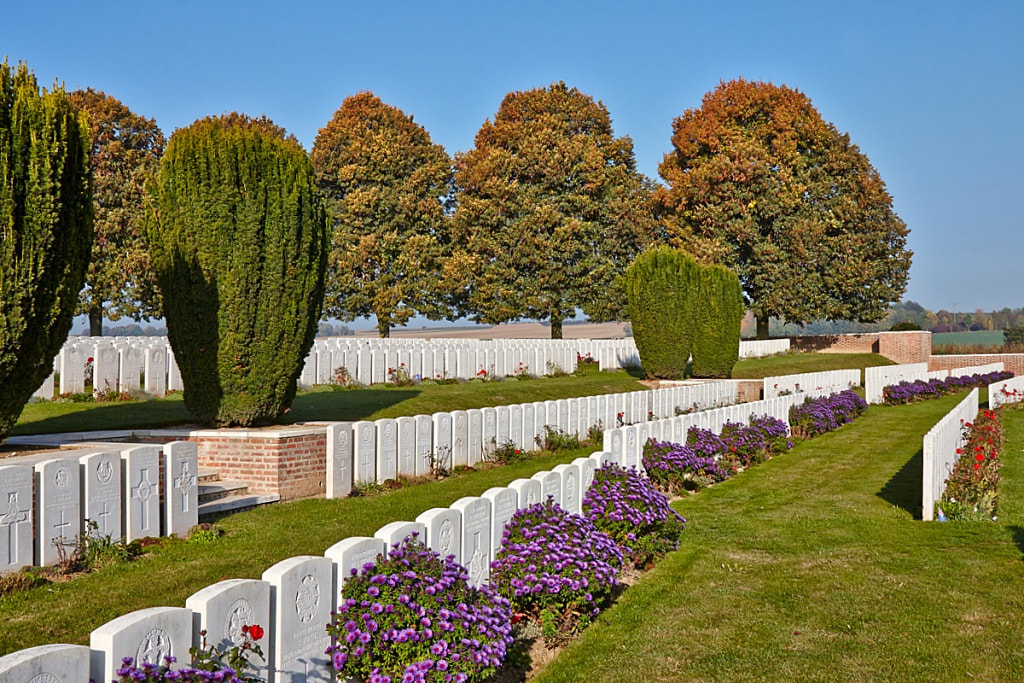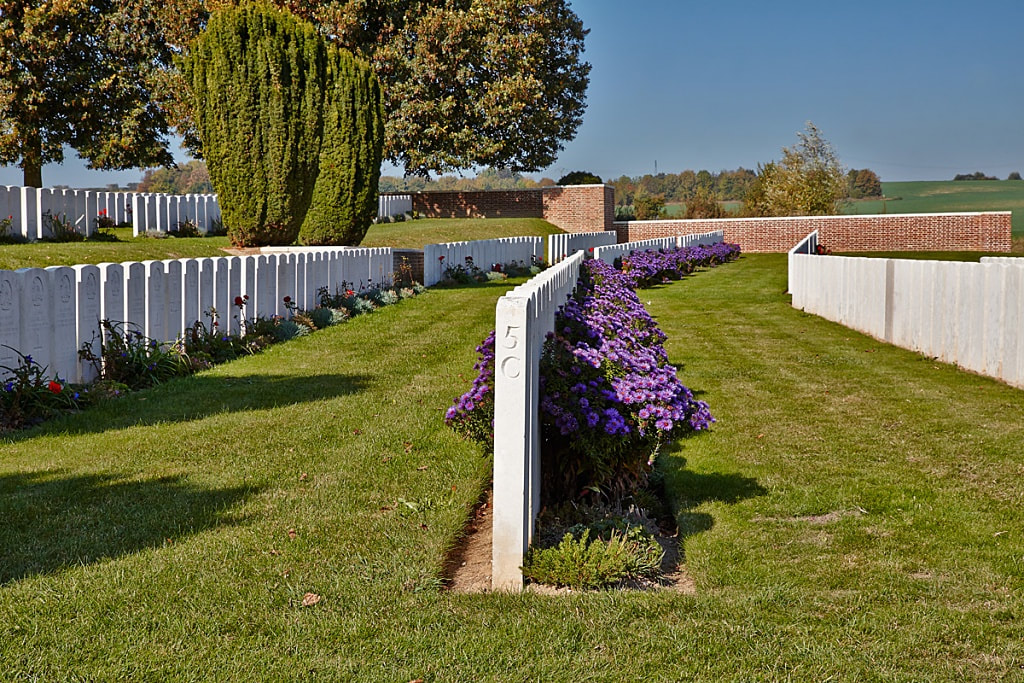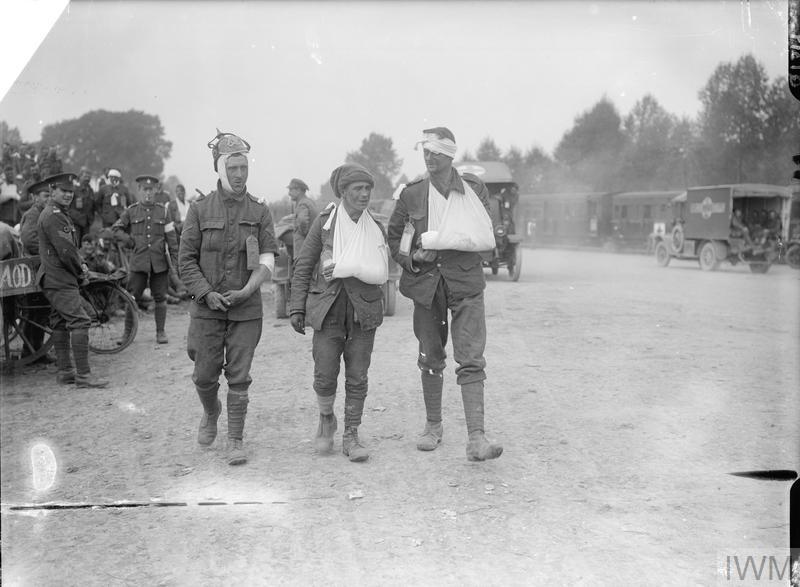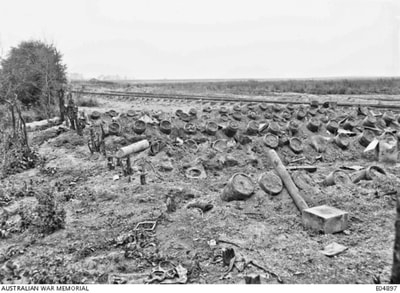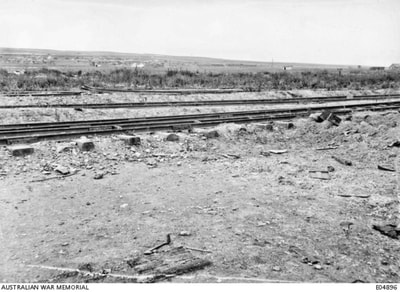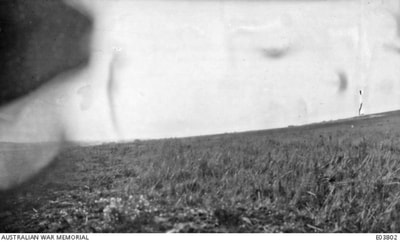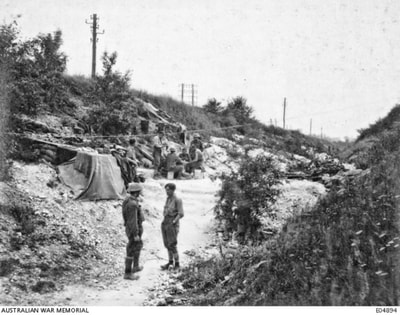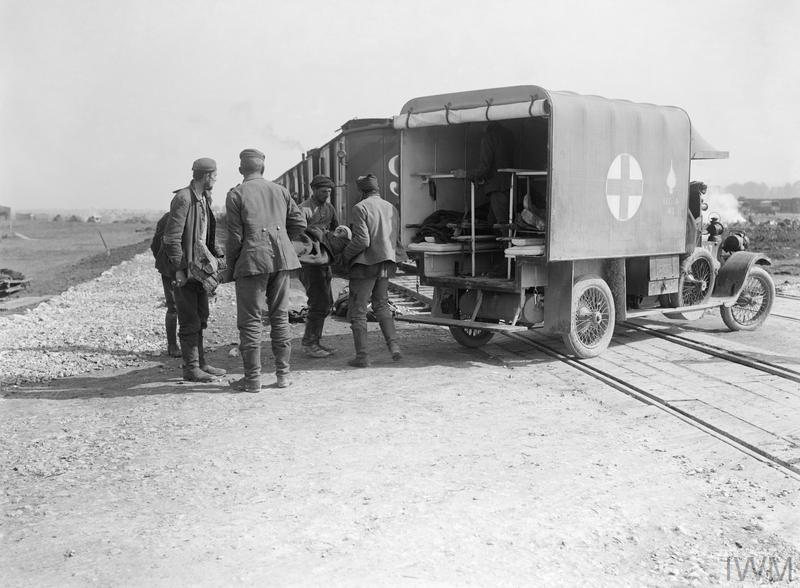DERNANCOURT COMMUNAL CEMETERY EXTENSION
Somme
France
Latitude: 49.97684, Longitude: 2.62496
Roll of Honour
Listed by Surname
Location Information
Dernancourt is a village 3 kilometres south of Albert. The Communal Cemetery is a little west of the village, and the Extension is on the north-west side of the Communal Cemetery.
Visiting Information
The location or design of this site makes wheelchair access impossible.
Historical Information
Field ambulances used the Communal Cemetery for Commonwealth burials from September 1915 to August 1916, and again during the German advance of March 1918. It contains 127 Commonwealth burials of the First World War.
The XV Corps Main Dressing Station was formed at Dernancourt in August 1916, when the adjoining EXTENSION was opened. The 45th and 56th (1st/1st South Midland) Casualty Clearing Stations came in September 1916 and remained until March 1917. The 3rd Australian was here in March and April 1917, and the 56th from April 1917 to February 1918. The 3rd Casualty Clearing Station came in March 1918 but on 26 March, Dernancourt was evacuated ahead of the German advance, and the extension remained in their hands until the village was recaptured on 9 August 1918 by the 12th Division and the 33rd American Division. In September it was again used by the 47th, 48th and 55th Casualty Clearing Stations under the name of "Edgehill", due to the rising ground on the north-west.
At the Armistice, the Extension contained more than 1,700 burials; it was then enlarged when graves were brought in from isolated positions in the immediate neighbourhood and certain small cemeteries, including:-
MOOR CEMETERY, EDGEHILL, DERNANCOURT, was about 800 metres West, near the top of the hill. It contained the graves of 42 soldiers from the United Kingdom who fell on the 23rd-25th March, 1918.
ALBERT ROAD CEMETERY, BUIRE-SUR-ANCRE, was nearly 3 Kms West, on the straight road from Amiens to Albert. It contained the graves of 65 soldiers from the United Kingdom and 33 from Australia, who fell in April-August, 1918. It was made by Australian units and by the 58th (London) and 12th Divisions.
The extension now contains 2,162 Commonwealth burials and commemorations of the First World War. 177 of the burials are unidentified, but there are special memorials to 29 casualties known or believed to be buried among them, and to two buried at Albert Road Cemetery, Buire-sur-Ancre whose grave could not be found on concentration.
Total Burials: 2,167.
Identified Casualties: United Kingdom 1,514, Australia 378, New Zealand 50, South Africa 30, Canada 8, India 6, Germany 1. Total 1,987.
The extension was designed by Sir Edwin Lutyens and George Hartley Goldsmith
358 Serjeant Thomas James Harris, V. C., M. M.
6th Bn. Queen's Own (Royal West Kent Regiment)
9th August 1918, aged 26.
Plot VIII. J. 20.
Son of William John and Sarah Ann Harris, of 6, Manor Terrace, Halling, Rochester, Kent.
His headstone bears the inscription "In Loving Remembrance Of Our Dear Son"
Citation: An extract from The London Gazette, No. 30967, dated 18th Oct., 1918, records the following:- "For most conspicuous bravery and devotion to duty in attack when the advance was much impeded by hostile machine guns concealed in crops and shell-holes. Serjt. Harris led his section against one of these, capturing it and killing seven of the enemy. Later, on two successive occasions, he attacked single-handed two enemy machine-guns which were causing heavy casualties and holding up the advance. He captured the first gun and killed the crew, but was himself killed when attacking the second one. It was largely due to the great courage and initiative of this gallant N.C.O. that the advance of the battalion was continued without delay and undue casualties. Throughout the operations he showed a total disregard for his own personal safety, and set a magnificent example to all ranks."
A Hero from Halling
By Tony Grant
Thomas Harris was the son of William John and Sarah Ann Harris of Halling, Kent, the seventh child of a family of nine children. He attended Halling Board School (Infants) from the 7th July 1896. It is assumed he worked at Hilton & Anderson’s Manor Cement Works after leaving school, enlisting on the 27th August 1914 aged 22, joining The Queens Own Royal West Kent Regiment, and travelling to France on the 1st June 1915. He was made a Lance Corporal on the 9th July 1915, being promoted to Corporal on the 1st June 1916 and then acting Sergeant on the 28th March 1918. He was awarded his Military Medal on the 9th April 1918, possibly for actions in the period 25th - 28th March 1918 near Authuille, Somme. He was confirmed in the rank of Sergeant on the 24th June 1918 and was posthumously awarded his V.C. for his actions during an attack on the 9th August 1918. During the period from the 26th February 1916 to the 2nd July 1916, he was wounded on two occasions. Following the first occasion on the 26th February 1916, he was admitted to hospital from the 27th February to the 4th March and returned to duty on the 12th March 1916 (no further details are available). On the 2nd July 1916 he received a shrapnel wound to his right side which entailed his return to England on a hospital ship and his admission to hospital between the 8th July and the 25th August 1916, with his return to France on the 23rd. May 1917. If the research and assumptions are correct his M.M. was awarded to him, possibly for his actions while in “B” Company, which took part in the following defensive action.
“On the 21st March 1918, following a five-hour bombardment by over 6,000 guns, one million German soldiers attacked, in thick fog, along a 50-mile front opposite the British Third and Fifth armies. The Fifth Army, under General Gough, who had consistently warned the GOC of the weakness of his position, fell back towards Amiens in the face of the onslaught. Barely a week later Gough was blamed for the retreat and replaced by Rawlinson. Haig asked the French for support and brought the Australians down from the north. On the 11th April, Haig issued a “ Special Order of the day “, saying that “ ….. There is no other course open to us but to fight it out!…. With our backs to the wall and believing in the justice of our cause, each one of us must fight on to the end. “ The German advance towards Amiens finally stopped on the 24th April when tank first met tank at Cachy and the following morning the Australians re-took Villers Bretonneux. It was ANZAC Day.”
(Historical Summary 1918 from Major & Mrs. Holt’s Battlefield Guide to the Somme.)
“(25th March 1918) Two days after misfortune had overtaken the 10th Battalion, the 6th took up the effort to stem the German advance. This battalion had been pushed off in haste from Pont de Nieppe on the 23rd, and after a long and tiring journey in motor buses had arrived at Bouzincourt just North of Albert early on March 25th. After some hours of waiting, the 37th Brigade at last received orders to cross the Ancre and take up the line Montauban-Bazentin le Grand, but as it moved forward these orders were cancelled and Contalmaison substituted as its goal. However, as its leading battalion, The Queen’s, reached Orvillers, the Forty-Seventh Division demanded the assistance of the brigade in a counter attack on Pozieres on which place the Germans were reported to be advancing. The Queen’s and the battalion were detailed for this but before the attack could be launched it also was cancelled and orders were issued to take up an outpost line outside the Bapaume-Albert road near Ovillers, the battalion being on the right of the brigade with the Forty-Seventh Division beyond it. In this position the night was spent. Patrols found Pozieres unoccupied, so a screen was formed to cover the destruction of a vast dump at that village which was finally fired about 9.45 p.m. But a position East of the Ancre could no longer be maintained and during the night the Forty-Seventh Division and the fragments which had rallied on it fell back to the right bank, the 37th. Brigade following suit as soon as the Forty-Seventh were across. (26th. March 1918) Crossing the Ancre at Aveluy Bridge the 36th Brigade were found taking up the position just West of the river, so the 37th moved upstream to continue the line to the North. Brigade Headquarters were established at Martinsart and the battalion took up its position in front of Aveluy Wood from opposite Authuille to a point due east of Mesnil, hence the 6th Queen’s continued the line Northward to Hamel. Beyond The Queen’s were portions of the Sixty-Third Division whom the Twelfth were relieving. The position was not bad, as the ground rose fairly steeply from the Ancre, which at this point was quite a considerable obstacle, but there were scarcely any prepared defences. However, by this time the force and pace of the German advance had both abated. They had won much ground but they had paid dearly for their gains, and the difficulties of keeping their advanced troops supplied were already proving a serious handicap, and though they made many attacks these lacked the weight and power of their earlier efforts. That evening some few Germans got into Aveluy Wood, having apparently got through the line of A Company, but they were effectively counter-attacked by Colonel Dawson with the personnel of battalion headquarters and some Buffs, and driven back with heavy losses, two of their machine guns being taken, while further to the right B beat off some assailants. (27th. March 1918) A more serious attack on the Queen’s was also repulsed and some prisoners taken and the brigades line was successfully maintained, as was also the case all through the morning and afternoon of the 27th, though shelling increased. That evening, about 6 p.m., the Germans renewed their attack; they had already forced back the troops further to the left, and The Queen’s had therefore to evacuate Hamel and throw back their flank. The pressure on the battalion was severe; one attack all along the line was beaten off, but a little later the enemy forced B Company back. Some Germans also got through a gap on the left, but 2nd. Lieut. Guess organized a counter-attack which drove them out and re-established the line , and B managed to make a stand along the line of the railway. But the Germans were not done with. The next morning saw the battalion subjected to an intense bombardment and the enemy, who had made some progress further to the right in the direction of Bouzincourt, were able by means of enfilade machine-gun fire to make the railway cutting untenable. B Company fell back, therefore, about 11 a.m., but Colonel Dawson managed to form a defensive flank and to prevent the Germans advancing any further. A company of the 24th. Royal Fusiliers, of the Second Division, was placed at his disposal and at 1.45, after half-an-hour’s bombardment, he launched a counter attack, using this company and all the reserves of the battalion. The stroke was delivered with great spirit and success, 2nd. Lieut. Slade, who had already headed two counter-attacks, being well to the fore; the enemy was dislodged and thrust down the slopes into the valley, suffering heavily, and at 3 p.m. Colonel Dawson could report that the line had been fully re-established. The determination, promptness and energy which he had displayed and which had inspired the battalion to put up so stout a fight were deservedly rewarded by yet another bar to his D.S.O., 2nd Lieuts. Guess and Slade receiving the M.C.”
(The Queens’ Own Royal West Kent Regiment 1914-1919 by C.T. Atkinson)
The action resulting in the award of his V.C. was set against the following historical and specific details. It was the beginning of the final “100 days” that led to the Armistice of the 11th November 1918. In the first phase of General Haig’s Amiens offensive (August 1918), the 1st, 6th and 7th Battalions of the Royal West Kent Regiment were prominent. August 8th. was according to Ludendorff (German Commander), “ the black day of the war for the German armies”.
“Only the 7th Battalion (part of the 18th Division) was actively engaged in an attack on the 8th August 1918, commencing across the Bray-Corbie road and ending, after a day of desperate, heavy and heroic fighting, at a line threatening Morlancourt from the North-West with the 3rd Corps, of which they were part, inflicting heavy casualties on the Germans and taking over 2,000 prisoners. The 6th Battalion (part of the 12th Division) was in Divisional reserve and spent the day in readiness at Franvillers. After receiving orders it moved up in the evening to Marrett Wood, West of Morlancourt, to continue the attack next morning. In the attack on the 9th, the 6th Battalion Royal West Kents, part of the 37th Brigade, got its chance. The line reached on the 8th ran North-East of Ville sur Ancre and was close up to the edge of Morlancourt. At 8.35 p.m. on the 8th orders were received for a renewal of the attack at 4.30 a.m. on the 9th; at midnight the operation was postponed to 5.30 a.m., and at 1.45 a.m. on the 9th there was a second postponement to 5.30 p.m. The 37th Brigade had taken up its position before the latest orders reached it, and the 6th Buffs, attacking at 5.30 a.m., without artillery support, succeeded in penetrating the enemy’s position and capturing a machine gun, ten trench mortars and some prisoners. On receiving the fresh orders the attack was stopped and the troops were withdrawn to the assembly point. The 6th. Battalion R.W.K.(Dawson) was on the left of the attack with The Queen’s and Buffs beyond it, and assembled along the Morlancourt-Ville sur Ancre road. The 6th Queen’s were in the centre, and the 6th R.W.K. on the left (North), when at 5.30 p.m. the attack assisted by tanks and under a creeping barrage, was renewed. The 6th Buffs, on the right (South), starting again south of Morlancourt, met with severe opposition, a field gun firing over open sights causing considerable casualties, and holding up the advance. The 6th Queen’s, attacking to the north of Morlancourt, were held up by a strong point. The 6th R.W.K. advance was met by considerable opposition from machine guns skilfully concealed in the cornfields and in shell holes, and for a moment the attack seemed bound to be held up. That this did not happen was due to the gallantry and devotion of Sgt. T. J. Harris, who rushed one of these guns at the head of his section and captured it killing seven of the enemy. Twice again as the advance proceeded the same thing happened; each time Sgt. Harris dashed forward against the obstructing machine-gun. In the first instance he was again successful, killing the whole team single-handed: the second time he was himself shot, but his example had inspired all those round him and the advance swept on.” (The Queens’ Own Royal West Kent Regiment 1914-1919 by C.T. Atkinson & History of the 12th. Division)
For his actions in this part of the attack Thomas Harris was awarded a posthumous V.C. and for this involvement and deeds he carried out later 2nd. Lieut. Upfold received the M.C.
“A conspicuous feature of the day was Colonel Dawson’s leadership: he went into battle on horseback, exposing himself fearlessly and setting an example of calmness and courage which was most inspiring to his men. 2nd Lieut. H.J. Turner was also prominent in this advance. Machine guns concealed in the low-lying ground near the river were inflicting casualties on his company, but he skilfully manoeuvred his men into a position from which they could take the enemy in flank and rear and so cleared them out of the way. 2nd. Lieut. Upfold also twice successfully disposed of machine guns which were holding up his platoon, by engaging them in front and thereby diverting the attention from parties who rushed them from the flank. Thus the Battalion achieved an advance of over 2,000 yards, captured or destroyed over 20 machine guns and four trench-mortars, made a substantial haul of prisoners and consolidated its final objective which ran South East from the Ancre just East of Dernancourt. In this Captain Henderson-Roe set a splendid example: his left arm was badly shattered early on, but he continued nevertheless to lead his company forward with marked skill and leadership and insisted on remaining at the front until the position had been consolidated. As well as 2nd. Lieut. Upfold, Captain Henderson-Roe and 2nd. Lieut. Turner also received the M.C.”
(The Queens’ Own Royal West Kent Regiment 1914-1919 by C.T. Atkinson)
An extract from the London Gazette No. 30967, Ninth Supplement dated the 22nd October 1918 to that dated the 18th October 1918, records the following;-
For most conspicuous bravery and devotion to duty in attack His Majesty the King has been graciously pleased to approve the award of the Victoria Cross to No. G/358 Sjt. Thomas James Harris, M. M., Late R.W.Kent R. (Lower Halling, Kent). It was largely due the great courage and initiative of this of this gallant N.C.O. that the advance of the battalion was continued without delay and undue casualties. Throughout the operation he showed a total disregard for his own personal safety, and set a magnificent example to all ranks. Thomas’s platoon commander 2nd. Lieutenant S. J. Upfold, who was with him on the final attempt and was wounded in the attack but survived, later wrote to Thomas’ parents at Halling of the events of that evening, September 27th, 1918:
Dear Mrs. Harris, It is with a feeling of profound sympathy that I address myself to you. The blow you have sustained in the loss of your extremely gallant son, is an irreparable one, and I feel very deeply with you and your husband in your bereavement. I was the officer in charge of the platoon to which your son was attached, and was the only person near him when he was killed, for as a matter of fact we were within a yard of one another when the bullets struck him and he fell into my arms. His death was practically instantaneous, for he just smiled, sent his love to his mother and his father, wished me good-bye, and his gallant spirit was gone to the place where there is no pain, and where suffering is unknown. He was killed by fire from a machine gun which was holding up the whole advance, and at the time he was assisting me in an endeavour to get at it and silence it. This was on the evening of the 9th August, and we were about half-way through an attack, which carried us forward approximately two miles, and it actually occurred about a mile from the small village of Ville-sur-Ancre, some little distance south-east of Albert. We had gone over about 6.30 p.m., and went forward in the face of very heavy machine gun fire. Sergeant Harris performed many heroic acts, and behaved with the utmost gallantry, not once, but continually, and his example was a very fine one to the men. I have never seen a braver man, totally unafraid, doing his duty nobly, with an utter disregard for his own personal safety, and encouraging his men splendidly. He covered himself with glory, and I afterwards put his name forward as worthy of decoration. His valour was remarkable, and he was a credit to himself, to his Regiment, and to his parents. Earlier in the attack, while the whole Company was held up by machine gun fire, he went forward alone, without waiting for orders, and rushed the gun, killing some of the crew, and compelling the remainder to surrender. He met his death while accompanying me in getting another gun. I had crawled forward towards it, and in gathering myself together for a final rush, discovered that your son, with a devotion that touched me very, very deeply, had crawled after me, refusing to allow me to go forward without assistance, and, unasked, had taken it upon himself to share the risk with me. It was the most magnificent thing one man could do for another, and it is only on such occasions, when death is all round, that one discovers the worth of a man like your son. The moment we got up Sergeant Harris dashed forward and was shot down by my side. With his last breath came the message for his mother, indeed his last thoughts were for you, and if anything can be a satisfaction to you under the weight of such a blow, I personally saw to it that not one of the machine gun crew were left alive, for I was as upset as though he had been my own brother, for he was such an extremely devoted N.C.O., that I had grown to develop a great respect for his courage and ability. I did all I could for him, but it was impossible to save his life, because he was killed almost at once and suffered no pain. He was buried afterwards close to Dernancourt. Personally I experienced a feeling of great loss when he went, for I had a good deal to do with him, and many opportunities of judging his sterling worth. I always found him absolutely trustworthy, full of the most sublime courage, and always willing to do more than his duty under any circumstances. All the officers thought very highly of him, and he was exceedingly popular with the men. Magnificent under fire he performed prodigies of valour, and was absolutely invaluable to me. He died very gallantly, faithful to the last, and I reported his exceptional bravery to the higher authorities after we had ultimately reached our objective. I wish to tender you my very deepest and most heartfelt sympathy and to assure you that you have every reason to be proud of so gallant a son as Sergeant Harris.
S. J. UPFOLD, 2nd Lieut., R.W.K.R.
Thomas’ mother, Sarah, replied to Lieutenant Upfold immediately after receiving his letter. No details of this letter are available; his response in October when he expressed further sympathy to the family and spoke of his slow recovery was as follows:-
11th October, 1918.
Dear Mrs. Harris,
Thank you for your letter, and for your kindly expressed sympathy with me. I am very glad to have been able to have told you all you wanted to know about your extremely gallant son, and you may indeed feel justly proud of him. Germany can never hope to win when such men as your son are in the British Army. It is of course, a very heavy blow to lose him, but it softens the pain when you know he met his end as a real hero, a credit to you, to himself, and to his Regiment. I can sympathise with you very deeply, for I lost my favourite brother out there, and I know the awful agony such a thing means; but, believe me, a man is not afraid to die when, by risking his life he is keeping those loved ones at home from the awful horrors we have had proof that invasion by the unspeakable Hun means. Your son died for England and for the cause of Right, but he died too, that all whom he loved might live, and it is the greatest thing a man can do. I am glad to say that I am getting along pretty well, although they tell me that it will take a long time for me to get right.
S. J UPFOLD, 2nd Lieut., R.W.K.R.
One day later he wrote again with the news that Thomas Harris had been awarded the Victoria Cross:- 12th October, 1918.
Dear Mrs. Harris, I am extremely glad to be able to inform you that I have just received a letter from my Colonel in France, telling me that your son, Sergeant Harris has won undying fame, for His Majesty the King has been pleased to bestow upon him the highest honour a soldier can ever hope to attain, i.e., the Victoria Cross. The Colonel will be personally writing to you. In your great sorrow, the great honour won by your son will bring you consolation, for it will show more clearly than words of mine can express how magnificently he behaved, and I can assure you that I am proud to have been with him, proud to have shared his exploits, proud, immensely proud, to have been his officer. Not only has he won fame for himself and honour to his family, but he has also brought it to the Regiment he loved so well, for he is the first V.C. of the Royal West Kent Regiment. I know nothing can lessen the pain caused by his loss, but you have now the glorious knowledge that he was the bravest and most gallant man in the Regiment, and you have every reason to be proud of him who has brought such great honour to you. Sympathising with you as I do, I am happy to be the first to notify you of this, and to offer you my very heartiest congratulations, for although your gallant son has fallen, his name will live for ever, to be emblazoned on the scroll of fame as one of England's heroes.
S. J. UPFOLD, M.C., 2nd Lieut., R. West Kent Rgt. P.S. I have been awarded the Military Cross.
The Rochester, Chatham and Gillingham News of 19th October 1918 had this to say:
“A Halling Hero. Posthumous Award of the Victoria Cross.
Mr. and Mrs. W Harris, of 6 Manor Terrace, Halling, have this week received the gratifying news that the V.C. has been posthumously awarded to their gallant son, Sergeant Thomas James Harris, Royal West Kent Regiment, aged 24 (sic) years (whose death was announced in the "The News" of September 14th), for conspicuous bravery on the battlefield. We append copies of letters which have been received by his mother from the Officer Commanding his platoon, which speak volumes for the valour of the deceased sergeant. Although the "Fighting West Kents" have performed many heroic deeds, and covered themselves with glory in the present great war, it is a fact that no individual soldier or officer had been previously awarded the much-coveted V.C. The decoration will therefore be doubly prized by his bereaved parents. Sergeant Harris received his education in the Halling Council School, consequently the Headmaster, staff, pupils and managers rejoice at the honour done to his memory, and a similar feeling prevails among his late employers and fellow workmen, and among the residents generally.”
The medal itself was presented to Tom's parents after the war by the King in a ceremony at Buckingham Palace and later it passed to their son Herbert George. Some years later the family donated both medals, the VC and MM, to the Royal West Kent Regiment, and today they are on display in their museum at Maidstone. In 1999 a party of school children from Meopham were due to visit World War I sites in France and Colin S Martin gave them the location of Thomas Harris' war grave (obtained from the Commonwealth War Graves Commission) for them to visit if they wished. The students did indeed visit the site, laying a wreath on the grave, taking photographs, and reflecting on Sergeant Harris' death 81 years ago. The school magazine later recorded that Year 10 History visited the battlefields and the Dernancourt cemetery and reported "...it was a deeply moving experience for all pupils and staff, ..and the tragedy and horror of it all still never fails to shock. Not one person was immune to the enormity of the loss of life". [The grave is No 20 in Row J Plot VIII at the Dernancourt Communal Cemetery Extension, Somme, France. Dernancourt is a village 3 kilometres south of Albert and is quite close to where Thomas was killed. The Communal Cemetery is a little west of the village, and the Extension is on the north-west side of the Communal Cemetery.]
For those of you who have found this of interest, may I recommend you visit Mike Chapman’s Web site on the Internet (the address is given below), who initially put me in contact with Richard & Doug Arman, Paul Oldfield and both Colin Martins who provided most of the information. If anyone should have any further information with regard to Thomas Harris I would be very pleased to receive it, in particular details of his employment prior to enlisting, the site of action of the award of the M.M. and its citation.
With acknowledgements to: - Colin S Martin (Cuxton); Centre for Kentish Studies, Maidstone; Colin Martin (Victoria. Aus.); The Royal West Kent Regiment Archive; Paul Oldfield; Medway Archive, Strood; Richard & Doug Arman (Aus.); Maidstone Library; Mike Chapman (www.chapter-one.com.uk); The Commonwealth War Graves Commission; The Guildhall Library, London. Some of the information in this article has been extracted from the following publications: - The Queen’s Own Royal West Kent Regiment 1914-1919 by C.T. Atkinson (Maidstone Library); History of the 12th. Division; The London Gazette; The Rochester, Chatham and Gillingham News ®
Article and image by kind permission of Tony Grant of Snodland, Kent
By Tony Grant
Thomas Harris was the son of William John and Sarah Ann Harris of Halling, Kent, the seventh child of a family of nine children. He attended Halling Board School (Infants) from the 7th July 1896. It is assumed he worked at Hilton & Anderson’s Manor Cement Works after leaving school, enlisting on the 27th August 1914 aged 22, joining The Queens Own Royal West Kent Regiment, and travelling to France on the 1st June 1915. He was made a Lance Corporal on the 9th July 1915, being promoted to Corporal on the 1st June 1916 and then acting Sergeant on the 28th March 1918. He was awarded his Military Medal on the 9th April 1918, possibly for actions in the period 25th - 28th March 1918 near Authuille, Somme. He was confirmed in the rank of Sergeant on the 24th June 1918 and was posthumously awarded his V.C. for his actions during an attack on the 9th August 1918. During the period from the 26th February 1916 to the 2nd July 1916, he was wounded on two occasions. Following the first occasion on the 26th February 1916, he was admitted to hospital from the 27th February to the 4th March and returned to duty on the 12th March 1916 (no further details are available). On the 2nd July 1916 he received a shrapnel wound to his right side which entailed his return to England on a hospital ship and his admission to hospital between the 8th July and the 25th August 1916, with his return to France on the 23rd. May 1917. If the research and assumptions are correct his M.M. was awarded to him, possibly for his actions while in “B” Company, which took part in the following defensive action.
“On the 21st March 1918, following a five-hour bombardment by over 6,000 guns, one million German soldiers attacked, in thick fog, along a 50-mile front opposite the British Third and Fifth armies. The Fifth Army, under General Gough, who had consistently warned the GOC of the weakness of his position, fell back towards Amiens in the face of the onslaught. Barely a week later Gough was blamed for the retreat and replaced by Rawlinson. Haig asked the French for support and brought the Australians down from the north. On the 11th April, Haig issued a “ Special Order of the day “, saying that “ ….. There is no other course open to us but to fight it out!…. With our backs to the wall and believing in the justice of our cause, each one of us must fight on to the end. “ The German advance towards Amiens finally stopped on the 24th April when tank first met tank at Cachy and the following morning the Australians re-took Villers Bretonneux. It was ANZAC Day.”
(Historical Summary 1918 from Major & Mrs. Holt’s Battlefield Guide to the Somme.)
“(25th March 1918) Two days after misfortune had overtaken the 10th Battalion, the 6th took up the effort to stem the German advance. This battalion had been pushed off in haste from Pont de Nieppe on the 23rd, and after a long and tiring journey in motor buses had arrived at Bouzincourt just North of Albert early on March 25th. After some hours of waiting, the 37th Brigade at last received orders to cross the Ancre and take up the line Montauban-Bazentin le Grand, but as it moved forward these orders were cancelled and Contalmaison substituted as its goal. However, as its leading battalion, The Queen’s, reached Orvillers, the Forty-Seventh Division demanded the assistance of the brigade in a counter attack on Pozieres on which place the Germans were reported to be advancing. The Queen’s and the battalion were detailed for this but before the attack could be launched it also was cancelled and orders were issued to take up an outpost line outside the Bapaume-Albert road near Ovillers, the battalion being on the right of the brigade with the Forty-Seventh Division beyond it. In this position the night was spent. Patrols found Pozieres unoccupied, so a screen was formed to cover the destruction of a vast dump at that village which was finally fired about 9.45 p.m. But a position East of the Ancre could no longer be maintained and during the night the Forty-Seventh Division and the fragments which had rallied on it fell back to the right bank, the 37th. Brigade following suit as soon as the Forty-Seventh were across. (26th. March 1918) Crossing the Ancre at Aveluy Bridge the 36th Brigade were found taking up the position just West of the river, so the 37th moved upstream to continue the line to the North. Brigade Headquarters were established at Martinsart and the battalion took up its position in front of Aveluy Wood from opposite Authuille to a point due east of Mesnil, hence the 6th Queen’s continued the line Northward to Hamel. Beyond The Queen’s were portions of the Sixty-Third Division whom the Twelfth were relieving. The position was not bad, as the ground rose fairly steeply from the Ancre, which at this point was quite a considerable obstacle, but there were scarcely any prepared defences. However, by this time the force and pace of the German advance had both abated. They had won much ground but they had paid dearly for their gains, and the difficulties of keeping their advanced troops supplied were already proving a serious handicap, and though they made many attacks these lacked the weight and power of their earlier efforts. That evening some few Germans got into Aveluy Wood, having apparently got through the line of A Company, but they were effectively counter-attacked by Colonel Dawson with the personnel of battalion headquarters and some Buffs, and driven back with heavy losses, two of their machine guns being taken, while further to the right B beat off some assailants. (27th. March 1918) A more serious attack on the Queen’s was also repulsed and some prisoners taken and the brigades line was successfully maintained, as was also the case all through the morning and afternoon of the 27th, though shelling increased. That evening, about 6 p.m., the Germans renewed their attack; they had already forced back the troops further to the left, and The Queen’s had therefore to evacuate Hamel and throw back their flank. The pressure on the battalion was severe; one attack all along the line was beaten off, but a little later the enemy forced B Company back. Some Germans also got through a gap on the left, but 2nd. Lieut. Guess organized a counter-attack which drove them out and re-established the line , and B managed to make a stand along the line of the railway. But the Germans were not done with. The next morning saw the battalion subjected to an intense bombardment and the enemy, who had made some progress further to the right in the direction of Bouzincourt, were able by means of enfilade machine-gun fire to make the railway cutting untenable. B Company fell back, therefore, about 11 a.m., but Colonel Dawson managed to form a defensive flank and to prevent the Germans advancing any further. A company of the 24th. Royal Fusiliers, of the Second Division, was placed at his disposal and at 1.45, after half-an-hour’s bombardment, he launched a counter attack, using this company and all the reserves of the battalion. The stroke was delivered with great spirit and success, 2nd. Lieut. Slade, who had already headed two counter-attacks, being well to the fore; the enemy was dislodged and thrust down the slopes into the valley, suffering heavily, and at 3 p.m. Colonel Dawson could report that the line had been fully re-established. The determination, promptness and energy which he had displayed and which had inspired the battalion to put up so stout a fight were deservedly rewarded by yet another bar to his D.S.O., 2nd Lieuts. Guess and Slade receiving the M.C.”
(The Queens’ Own Royal West Kent Regiment 1914-1919 by C.T. Atkinson)
The action resulting in the award of his V.C. was set against the following historical and specific details. It was the beginning of the final “100 days” that led to the Armistice of the 11th November 1918. In the first phase of General Haig’s Amiens offensive (August 1918), the 1st, 6th and 7th Battalions of the Royal West Kent Regiment were prominent. August 8th. was according to Ludendorff (German Commander), “ the black day of the war for the German armies”.
“Only the 7th Battalion (part of the 18th Division) was actively engaged in an attack on the 8th August 1918, commencing across the Bray-Corbie road and ending, after a day of desperate, heavy and heroic fighting, at a line threatening Morlancourt from the North-West with the 3rd Corps, of which they were part, inflicting heavy casualties on the Germans and taking over 2,000 prisoners. The 6th Battalion (part of the 12th Division) was in Divisional reserve and spent the day in readiness at Franvillers. After receiving orders it moved up in the evening to Marrett Wood, West of Morlancourt, to continue the attack next morning. In the attack on the 9th, the 6th Battalion Royal West Kents, part of the 37th Brigade, got its chance. The line reached on the 8th ran North-East of Ville sur Ancre and was close up to the edge of Morlancourt. At 8.35 p.m. on the 8th orders were received for a renewal of the attack at 4.30 a.m. on the 9th; at midnight the operation was postponed to 5.30 a.m., and at 1.45 a.m. on the 9th there was a second postponement to 5.30 p.m. The 37th Brigade had taken up its position before the latest orders reached it, and the 6th Buffs, attacking at 5.30 a.m., without artillery support, succeeded in penetrating the enemy’s position and capturing a machine gun, ten trench mortars and some prisoners. On receiving the fresh orders the attack was stopped and the troops were withdrawn to the assembly point. The 6th. Battalion R.W.K.(Dawson) was on the left of the attack with The Queen’s and Buffs beyond it, and assembled along the Morlancourt-Ville sur Ancre road. The 6th Queen’s were in the centre, and the 6th R.W.K. on the left (North), when at 5.30 p.m. the attack assisted by tanks and under a creeping barrage, was renewed. The 6th Buffs, on the right (South), starting again south of Morlancourt, met with severe opposition, a field gun firing over open sights causing considerable casualties, and holding up the advance. The 6th Queen’s, attacking to the north of Morlancourt, were held up by a strong point. The 6th R.W.K. advance was met by considerable opposition from machine guns skilfully concealed in the cornfields and in shell holes, and for a moment the attack seemed bound to be held up. That this did not happen was due to the gallantry and devotion of Sgt. T. J. Harris, who rushed one of these guns at the head of his section and captured it killing seven of the enemy. Twice again as the advance proceeded the same thing happened; each time Sgt. Harris dashed forward against the obstructing machine-gun. In the first instance he was again successful, killing the whole team single-handed: the second time he was himself shot, but his example had inspired all those round him and the advance swept on.” (The Queens’ Own Royal West Kent Regiment 1914-1919 by C.T. Atkinson & History of the 12th. Division)
For his actions in this part of the attack Thomas Harris was awarded a posthumous V.C. and for this involvement and deeds he carried out later 2nd. Lieut. Upfold received the M.C.
“A conspicuous feature of the day was Colonel Dawson’s leadership: he went into battle on horseback, exposing himself fearlessly and setting an example of calmness and courage which was most inspiring to his men. 2nd Lieut. H.J. Turner was also prominent in this advance. Machine guns concealed in the low-lying ground near the river were inflicting casualties on his company, but he skilfully manoeuvred his men into a position from which they could take the enemy in flank and rear and so cleared them out of the way. 2nd. Lieut. Upfold also twice successfully disposed of machine guns which were holding up his platoon, by engaging them in front and thereby diverting the attention from parties who rushed them from the flank. Thus the Battalion achieved an advance of over 2,000 yards, captured or destroyed over 20 machine guns and four trench-mortars, made a substantial haul of prisoners and consolidated its final objective which ran South East from the Ancre just East of Dernancourt. In this Captain Henderson-Roe set a splendid example: his left arm was badly shattered early on, but he continued nevertheless to lead his company forward with marked skill and leadership and insisted on remaining at the front until the position had been consolidated. As well as 2nd. Lieut. Upfold, Captain Henderson-Roe and 2nd. Lieut. Turner also received the M.C.”
(The Queens’ Own Royal West Kent Regiment 1914-1919 by C.T. Atkinson)
An extract from the London Gazette No. 30967, Ninth Supplement dated the 22nd October 1918 to that dated the 18th October 1918, records the following;-
For most conspicuous bravery and devotion to duty in attack His Majesty the King has been graciously pleased to approve the award of the Victoria Cross to No. G/358 Sjt. Thomas James Harris, M. M., Late R.W.Kent R. (Lower Halling, Kent). It was largely due the great courage and initiative of this of this gallant N.C.O. that the advance of the battalion was continued without delay and undue casualties. Throughout the operation he showed a total disregard for his own personal safety, and set a magnificent example to all ranks. Thomas’s platoon commander 2nd. Lieutenant S. J. Upfold, who was with him on the final attempt and was wounded in the attack but survived, later wrote to Thomas’ parents at Halling of the events of that evening, September 27th, 1918:
Dear Mrs. Harris, It is with a feeling of profound sympathy that I address myself to you. The blow you have sustained in the loss of your extremely gallant son, is an irreparable one, and I feel very deeply with you and your husband in your bereavement. I was the officer in charge of the platoon to which your son was attached, and was the only person near him when he was killed, for as a matter of fact we were within a yard of one another when the bullets struck him and he fell into my arms. His death was practically instantaneous, for he just smiled, sent his love to his mother and his father, wished me good-bye, and his gallant spirit was gone to the place where there is no pain, and where suffering is unknown. He was killed by fire from a machine gun which was holding up the whole advance, and at the time he was assisting me in an endeavour to get at it and silence it. This was on the evening of the 9th August, and we were about half-way through an attack, which carried us forward approximately two miles, and it actually occurred about a mile from the small village of Ville-sur-Ancre, some little distance south-east of Albert. We had gone over about 6.30 p.m., and went forward in the face of very heavy machine gun fire. Sergeant Harris performed many heroic acts, and behaved with the utmost gallantry, not once, but continually, and his example was a very fine one to the men. I have never seen a braver man, totally unafraid, doing his duty nobly, with an utter disregard for his own personal safety, and encouraging his men splendidly. He covered himself with glory, and I afterwards put his name forward as worthy of decoration. His valour was remarkable, and he was a credit to himself, to his Regiment, and to his parents. Earlier in the attack, while the whole Company was held up by machine gun fire, he went forward alone, without waiting for orders, and rushed the gun, killing some of the crew, and compelling the remainder to surrender. He met his death while accompanying me in getting another gun. I had crawled forward towards it, and in gathering myself together for a final rush, discovered that your son, with a devotion that touched me very, very deeply, had crawled after me, refusing to allow me to go forward without assistance, and, unasked, had taken it upon himself to share the risk with me. It was the most magnificent thing one man could do for another, and it is only on such occasions, when death is all round, that one discovers the worth of a man like your son. The moment we got up Sergeant Harris dashed forward and was shot down by my side. With his last breath came the message for his mother, indeed his last thoughts were for you, and if anything can be a satisfaction to you under the weight of such a blow, I personally saw to it that not one of the machine gun crew were left alive, for I was as upset as though he had been my own brother, for he was such an extremely devoted N.C.O., that I had grown to develop a great respect for his courage and ability. I did all I could for him, but it was impossible to save his life, because he was killed almost at once and suffered no pain. He was buried afterwards close to Dernancourt. Personally I experienced a feeling of great loss when he went, for I had a good deal to do with him, and many opportunities of judging his sterling worth. I always found him absolutely trustworthy, full of the most sublime courage, and always willing to do more than his duty under any circumstances. All the officers thought very highly of him, and he was exceedingly popular with the men. Magnificent under fire he performed prodigies of valour, and was absolutely invaluable to me. He died very gallantly, faithful to the last, and I reported his exceptional bravery to the higher authorities after we had ultimately reached our objective. I wish to tender you my very deepest and most heartfelt sympathy and to assure you that you have every reason to be proud of so gallant a son as Sergeant Harris.
S. J. UPFOLD, 2nd Lieut., R.W.K.R.
Thomas’ mother, Sarah, replied to Lieutenant Upfold immediately after receiving his letter. No details of this letter are available; his response in October when he expressed further sympathy to the family and spoke of his slow recovery was as follows:-
11th October, 1918.
Dear Mrs. Harris,
Thank you for your letter, and for your kindly expressed sympathy with me. I am very glad to have been able to have told you all you wanted to know about your extremely gallant son, and you may indeed feel justly proud of him. Germany can never hope to win when such men as your son are in the British Army. It is of course, a very heavy blow to lose him, but it softens the pain when you know he met his end as a real hero, a credit to you, to himself, and to his Regiment. I can sympathise with you very deeply, for I lost my favourite brother out there, and I know the awful agony such a thing means; but, believe me, a man is not afraid to die when, by risking his life he is keeping those loved ones at home from the awful horrors we have had proof that invasion by the unspeakable Hun means. Your son died for England and for the cause of Right, but he died too, that all whom he loved might live, and it is the greatest thing a man can do. I am glad to say that I am getting along pretty well, although they tell me that it will take a long time for me to get right.
S. J UPFOLD, 2nd Lieut., R.W.K.R.
One day later he wrote again with the news that Thomas Harris had been awarded the Victoria Cross:- 12th October, 1918.
Dear Mrs. Harris, I am extremely glad to be able to inform you that I have just received a letter from my Colonel in France, telling me that your son, Sergeant Harris has won undying fame, for His Majesty the King has been pleased to bestow upon him the highest honour a soldier can ever hope to attain, i.e., the Victoria Cross. The Colonel will be personally writing to you. In your great sorrow, the great honour won by your son will bring you consolation, for it will show more clearly than words of mine can express how magnificently he behaved, and I can assure you that I am proud to have been with him, proud to have shared his exploits, proud, immensely proud, to have been his officer. Not only has he won fame for himself and honour to his family, but he has also brought it to the Regiment he loved so well, for he is the first V.C. of the Royal West Kent Regiment. I know nothing can lessen the pain caused by his loss, but you have now the glorious knowledge that he was the bravest and most gallant man in the Regiment, and you have every reason to be proud of him who has brought such great honour to you. Sympathising with you as I do, I am happy to be the first to notify you of this, and to offer you my very heartiest congratulations, for although your gallant son has fallen, his name will live for ever, to be emblazoned on the scroll of fame as one of England's heroes.
S. J. UPFOLD, M.C., 2nd Lieut., R. West Kent Rgt. P.S. I have been awarded the Military Cross.
The Rochester, Chatham and Gillingham News of 19th October 1918 had this to say:
“A Halling Hero. Posthumous Award of the Victoria Cross.
Mr. and Mrs. W Harris, of 6 Manor Terrace, Halling, have this week received the gratifying news that the V.C. has been posthumously awarded to their gallant son, Sergeant Thomas James Harris, Royal West Kent Regiment, aged 24 (sic) years (whose death was announced in the "The News" of September 14th), for conspicuous bravery on the battlefield. We append copies of letters which have been received by his mother from the Officer Commanding his platoon, which speak volumes for the valour of the deceased sergeant. Although the "Fighting West Kents" have performed many heroic deeds, and covered themselves with glory in the present great war, it is a fact that no individual soldier or officer had been previously awarded the much-coveted V.C. The decoration will therefore be doubly prized by his bereaved parents. Sergeant Harris received his education in the Halling Council School, consequently the Headmaster, staff, pupils and managers rejoice at the honour done to his memory, and a similar feeling prevails among his late employers and fellow workmen, and among the residents generally.”
The medal itself was presented to Tom's parents after the war by the King in a ceremony at Buckingham Palace and later it passed to their son Herbert George. Some years later the family donated both medals, the VC and MM, to the Royal West Kent Regiment, and today they are on display in their museum at Maidstone. In 1999 a party of school children from Meopham were due to visit World War I sites in France and Colin S Martin gave them the location of Thomas Harris' war grave (obtained from the Commonwealth War Graves Commission) for them to visit if they wished. The students did indeed visit the site, laying a wreath on the grave, taking photographs, and reflecting on Sergeant Harris' death 81 years ago. The school magazine later recorded that Year 10 History visited the battlefields and the Dernancourt cemetery and reported "...it was a deeply moving experience for all pupils and staff, ..and the tragedy and horror of it all still never fails to shock. Not one person was immune to the enormity of the loss of life". [The grave is No 20 in Row J Plot VIII at the Dernancourt Communal Cemetery Extension, Somme, France. Dernancourt is a village 3 kilometres south of Albert and is quite close to where Thomas was killed. The Communal Cemetery is a little west of the village, and the Extension is on the north-west side of the Communal Cemetery.]
For those of you who have found this of interest, may I recommend you visit Mike Chapman’s Web site on the Internet (the address is given below), who initially put me in contact with Richard & Doug Arman, Paul Oldfield and both Colin Martins who provided most of the information. If anyone should have any further information with regard to Thomas Harris I would be very pleased to receive it, in particular details of his employment prior to enlisting, the site of action of the award of the M.M. and its citation.
With acknowledgements to: - Colin S Martin (Cuxton); Centre for Kentish Studies, Maidstone; Colin Martin (Victoria. Aus.); The Royal West Kent Regiment Archive; Paul Oldfield; Medway Archive, Strood; Richard & Doug Arman (Aus.); Maidstone Library; Mike Chapman (www.chapter-one.com.uk); The Commonwealth War Graves Commission; The Guildhall Library, London. Some of the information in this article has been extracted from the following publications: - The Queen’s Own Royal West Kent Regiment 1914-1919 by C.T. Atkinson (Maidstone Library); History of the 12th. Division; The London Gazette; The Rochester, Chatham and Gillingham News ®
Article and image by kind permission of Tony Grant of Snodland, Kent
Headstone
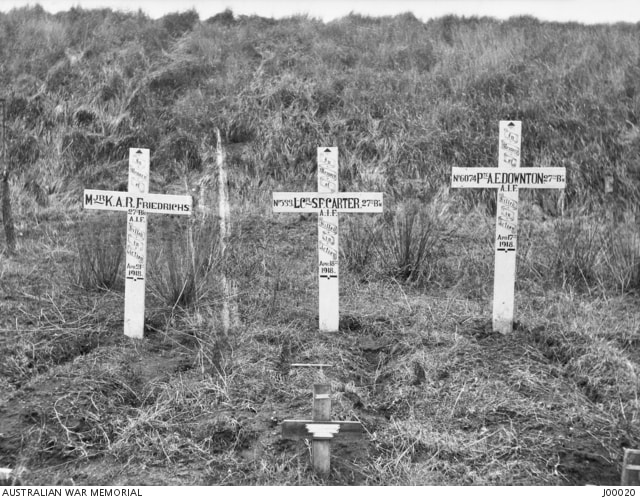
c. February 1919 - The isolated graves of Major Karl August Richard Friedrichs of Adelaide, SA, killed in action (KIA) 21 April 1918, and 533 Lance Corporal Stanley Frederick Carter of Adelaide, SA, KIA 18 April 1918, and 6074 Albert Edwin Downton of Queenstown, SA, KIA 17 April 1918, all of the 27th Battalion, and buried in Dernancourt Communal Cemetery Extension. This image is one of a set of photographs of the original graves of some members of the 27th Battalion. The Battalion funded the purchase of the camera through its adjutant Captain (Capt) Southon for 5541 Pte G R Barrington to photograph the graves.
Memories of Dernancourt
Reminiscences of Bob Booker, the son of a CWGC Gardener
My father was a war graves gardener based at Dernancourt during the late fifties and the early sixties, Dad was almost too young for WW2. But couldn’t be called up anyway as he was in a reserved occupation working in a factory on war equipment which he had been doing since leaving school. He was called up immediately after the war when he was both old enough, and the reserved occupations ended. He then served in Malaya during the Malayan campaign. After his national service he never returned to the factory but went into gardening. As a gardener he replied to a War Graves advert for gardeners. He was offered a job, and so we moved from Cornwall to Dernancourt in France in 1959 and we lived as a family on the other side of the railway bridge from the cemetery with just one farm house between us and the railway line. We also went to school in Dernancourt village. The posts which supported a chain link fence along the length of our back garden at Dernancourt were old British narrow gauge rails which had been used for moving war supplies somewhere and after the war had been recycled into fence posts.
As children in the late autumn and winter we used to follow the furrows after the plough looking for the scrap which was brought to the surface. In one particular field we would always find cutlery and kitchen type paraphernalia. On one occasion Dad helped a local farmer to widen a gateway just past the cemetery. It was a mutual task in that they needed top soil for levelling some ground in the cemetery. Whilst doing this they uncovered a listening post which had been buried for the past forty years. Some time ago I read a book of eye witness accounts which include one written about two soldiers who made their way to where the field canteen had been. This was after the German advance and after the allies had retreated from Dernancourt leaving their supplies behind. Whilst the Germans were in Dernancourt village they made their way at night along the side of the railway line up past the listening post to the remains of the canteen to retrieved what ever supplies they could find and carry. Of all the eye witness accounts which I used to read this was the most vivid. I had known the area so well and could follow accurately every move they made.
I remember once, after heavy rain a small amount of land slipped away from the railway embankment and a well rotted crate of German stick grenades slid down and opened it self up on the grass verge just by the railway bridge. The grenades just lay there at the side of the road where they had tumbled for weeks possibly months before they were cleared away. We just got used to them being there. On the other side of the bridge a small area was used by the farmers for stacking the unexploded shells which they unearthed whilst ploughing. These would gradually accumulate during the season as they dropped them off on their way back from the fields at the end of the day. In the spring these were collected for disposal by the authorities and the grenades must have stayed where they lay until they were removed at the same time as the shells. There were still a lot of horses in use in the early sixties; I remember a farmer who had a wooden box fitted to the back of his horse drawn plough, and if he unearthed a shell he would pop it into the box in front of the plough handles and carry on ploughing with the shell just in front of him.
During his 14 years as a War Graves Gardener we also lived in Albert, St. Pol-sur-Ternoise and also Ypres in Belgium where dad worked at the Menin Gate and the Ypres Reservoir Cemetery.
Reminiscences of Bob Booker, the son of a CWGC Gardener
My father was a war graves gardener based at Dernancourt during the late fifties and the early sixties, Dad was almost too young for WW2. But couldn’t be called up anyway as he was in a reserved occupation working in a factory on war equipment which he had been doing since leaving school. He was called up immediately after the war when he was both old enough, and the reserved occupations ended. He then served in Malaya during the Malayan campaign. After his national service he never returned to the factory but went into gardening. As a gardener he replied to a War Graves advert for gardeners. He was offered a job, and so we moved from Cornwall to Dernancourt in France in 1959 and we lived as a family on the other side of the railway bridge from the cemetery with just one farm house between us and the railway line. We also went to school in Dernancourt village. The posts which supported a chain link fence along the length of our back garden at Dernancourt were old British narrow gauge rails which had been used for moving war supplies somewhere and after the war had been recycled into fence posts.
As children in the late autumn and winter we used to follow the furrows after the plough looking for the scrap which was brought to the surface. In one particular field we would always find cutlery and kitchen type paraphernalia. On one occasion Dad helped a local farmer to widen a gateway just past the cemetery. It was a mutual task in that they needed top soil for levelling some ground in the cemetery. Whilst doing this they uncovered a listening post which had been buried for the past forty years. Some time ago I read a book of eye witness accounts which include one written about two soldiers who made their way to where the field canteen had been. This was after the German advance and after the allies had retreated from Dernancourt leaving their supplies behind. Whilst the Germans were in Dernancourt village they made their way at night along the side of the railway line up past the listening post to the remains of the canteen to retrieved what ever supplies they could find and carry. Of all the eye witness accounts which I used to read this was the most vivid. I had known the area so well and could follow accurately every move they made.
I remember once, after heavy rain a small amount of land slipped away from the railway embankment and a well rotted crate of German stick grenades slid down and opened it self up on the grass verge just by the railway bridge. The grenades just lay there at the side of the road where they had tumbled for weeks possibly months before they were cleared away. We just got used to them being there. On the other side of the bridge a small area was used by the farmers for stacking the unexploded shells which they unearthed whilst ploughing. These would gradually accumulate during the season as they dropped them off on their way back from the fields at the end of the day. In the spring these were collected for disposal by the authorities and the grenades must have stayed where they lay until they were removed at the same time as the shells. There were still a lot of horses in use in the early sixties; I remember a farmer who had a wooden box fitted to the back of his horse drawn plough, and if he unearthed a shell he would pop it into the box in front of the plough handles and carry on ploughing with the shell just in front of him.
During his 14 years as a War Graves Gardener we also lived in Albert, St. Pol-sur-Ternoise and also Ypres in Belgium where dad worked at the Menin Gate and the Ypres Reservoir Cemetery.

1st May 1918; The German offensive, 1918, its extreme forward limit at Dernancourt. Part of the battlefield of Dernancourt, near Albert, showing the village and church held by the Germans, and the railway line on which the 4th Australian Division originally relieved parts of the 9th and 35th British Divisions. After being checked here for a week, the Germans upon 5 April made with several Divisions a final attempt to break through towards Amiens. During the afternoon they had attained a position well up the hill in the foreground, but a counter attack at this juncture thrust them half way down the slope. (The photograph was taken from the Australian front line, and shows the German trench at the point where the German thrust was stopped).
Images in this gallery © Geerhard Joos
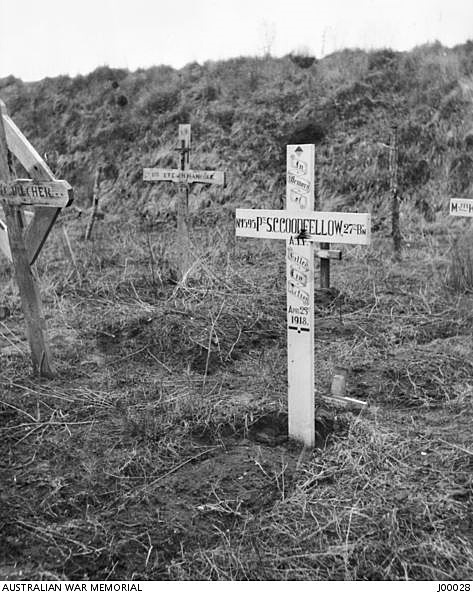
c. February 1919 - The graves of 1595 Private (Pte) Sturt Charles Goodfellow, 27th Battalion, 1228 Pte Sydney Charters Pilcher, 49th Battalion and 1118 Pte Philip Henry Hancock, 26th Battalion. Pte Goodfellow, a commercial traveller from North Unley, SA prior to enlistment, embarked with the 1st Reinforcements from Adelaide on HMAT Geelong on 31 May 1915 and was killed in action on 23 April 1918. Pte Pilcher, a farmer from Charters Towers, Qld prior to enlistment embarked with D Company, 42nd Battalion from Sydney on HMAT Borda on 5 June 1916. Later transferring to the 49th Battalion he was killed in action on 5 April 1918, aged 25. Pte Hancock, a labourer from Liffy, Tas prior to enlistment, embarked with D company from Brisbane on HMAT Aeneas on 29 June 1915 and on 27 April 1918 he was killed in action aged 26. All three men were buried in the Dernancourt Communal Cemetery Extension, France. This image is one of a set of photographs of the original graves of some members of the 27th Battalion. The Battalion funded the purchase of the camera through its adjutant Captain (Capt) Southon for 5541 Pte G R Barrington to photograph the graves.
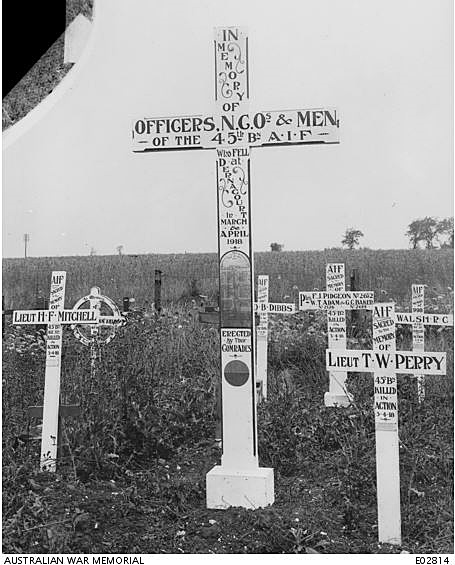
28th July 1918 - A memorial in memory of officers, NCOs and men of the 45th Battalion, AIF, who fell at Dernancourt following the operations of the Battalion in March and April 1918, erected by their comrades. Crosses mark the graves of, left to right, Lieutenant (Lt) Harold Flinders Mitchell; Captain Owen Burton Dibbs; 2672 Private (Pte) Francis John Pidgeon; 2126 Pte William Tasker Adam; 2619 Pte Guy Charles Baker; Lieutenant Theophilus William Perry; 998A Pte Richard Clarence Walsh.
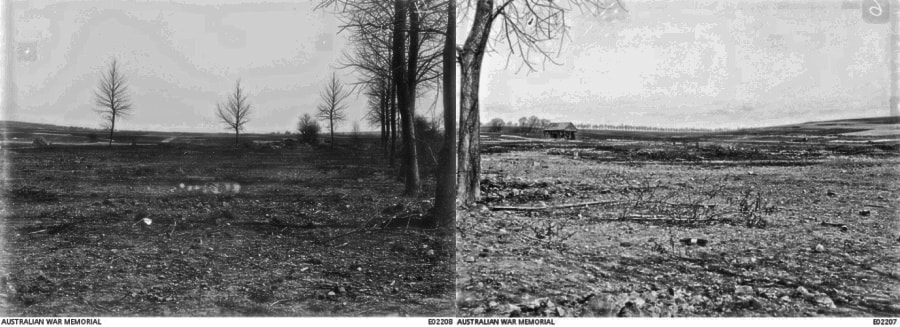
A view of the battlefield of Dernancourt. This area is where the 12th and 13th Australian Infantry Brigades broke the massed assaults of nearly four German divisions during their thrust towards Amiens on 5 April 1918. In the background on the far right are several unidentified structures. (Originally a 2 part picture)

